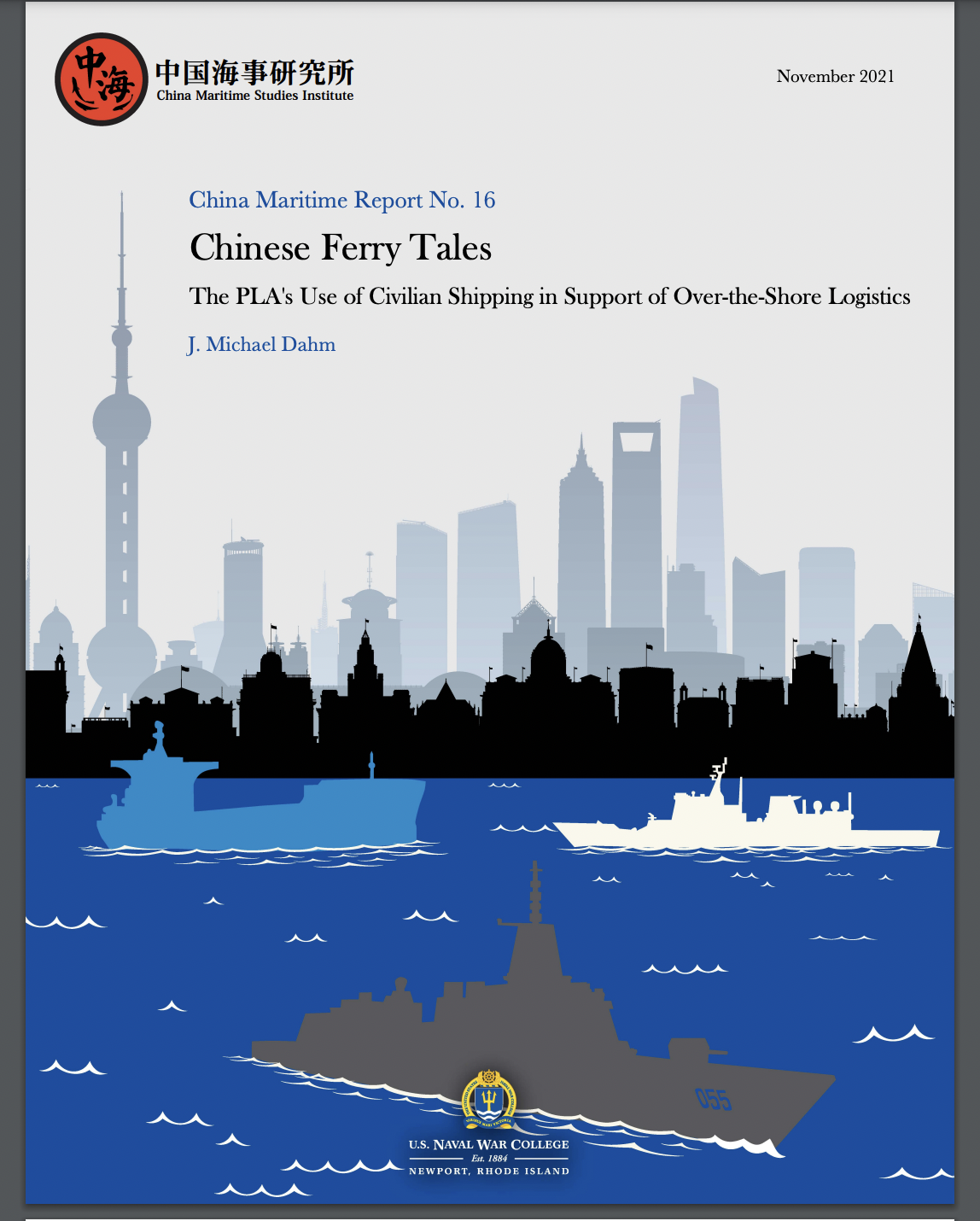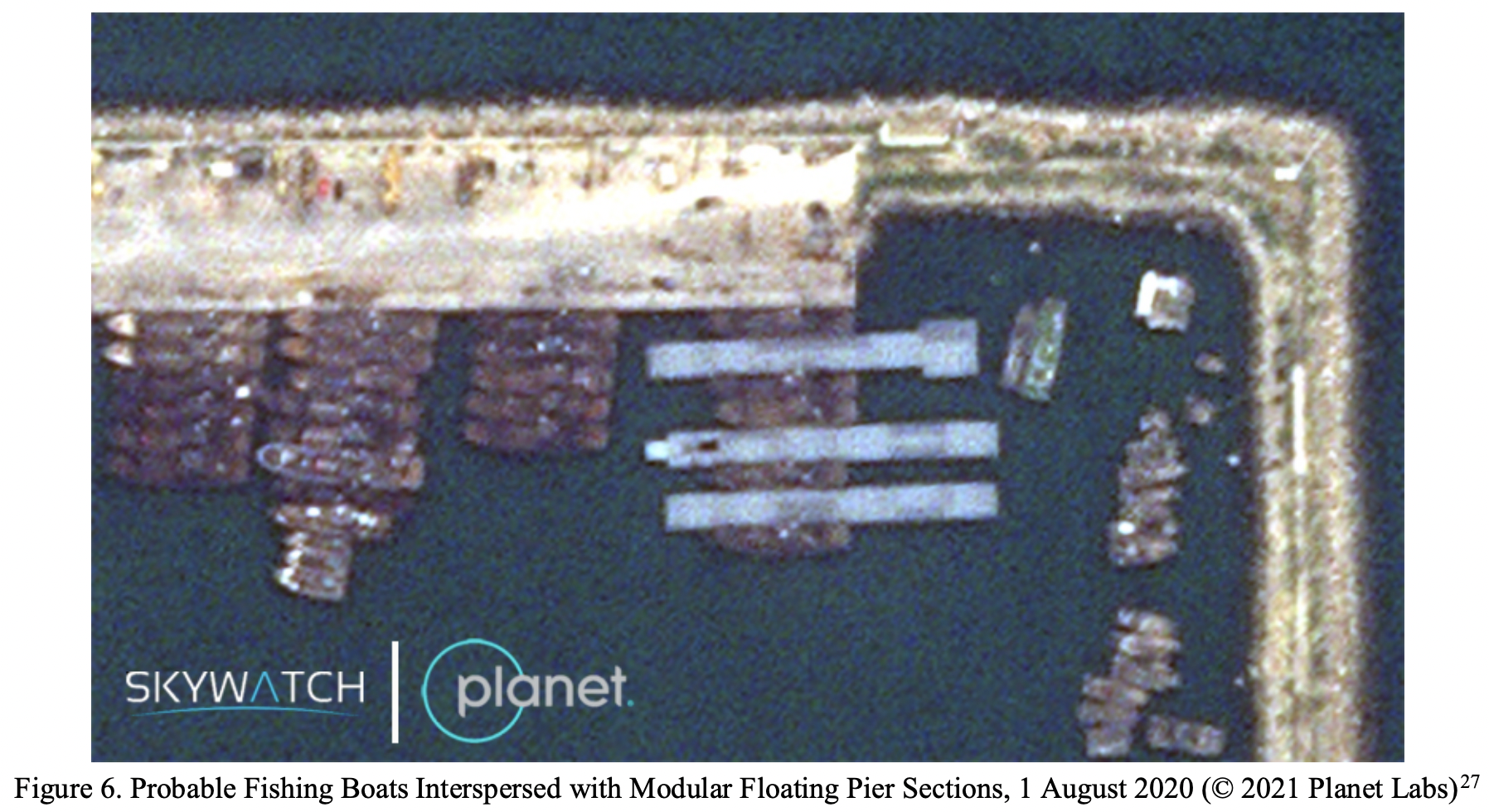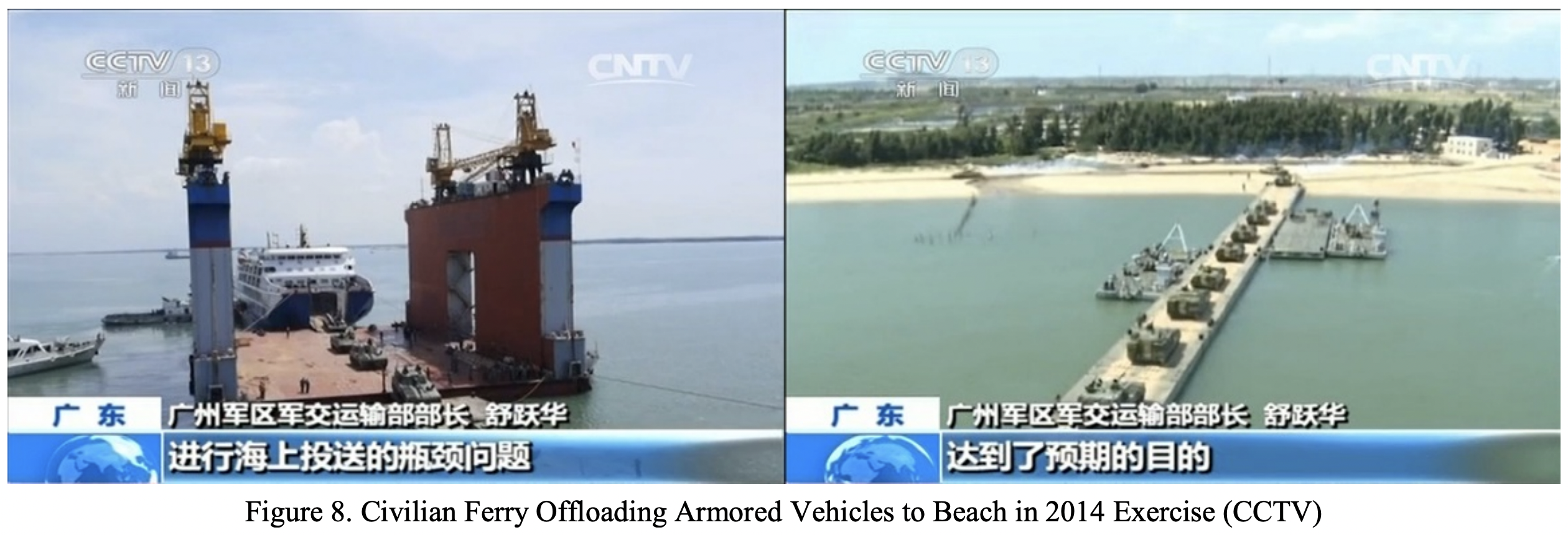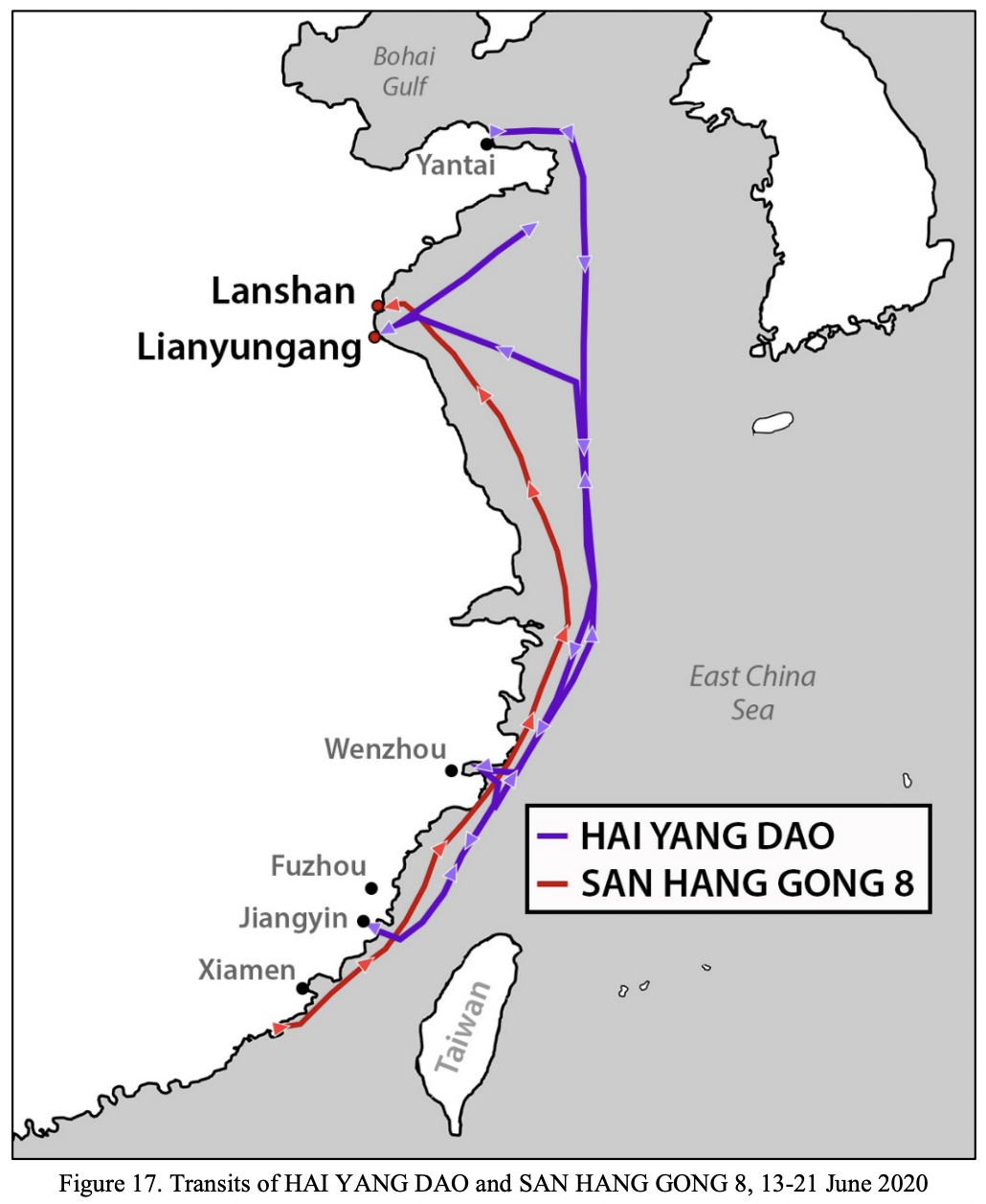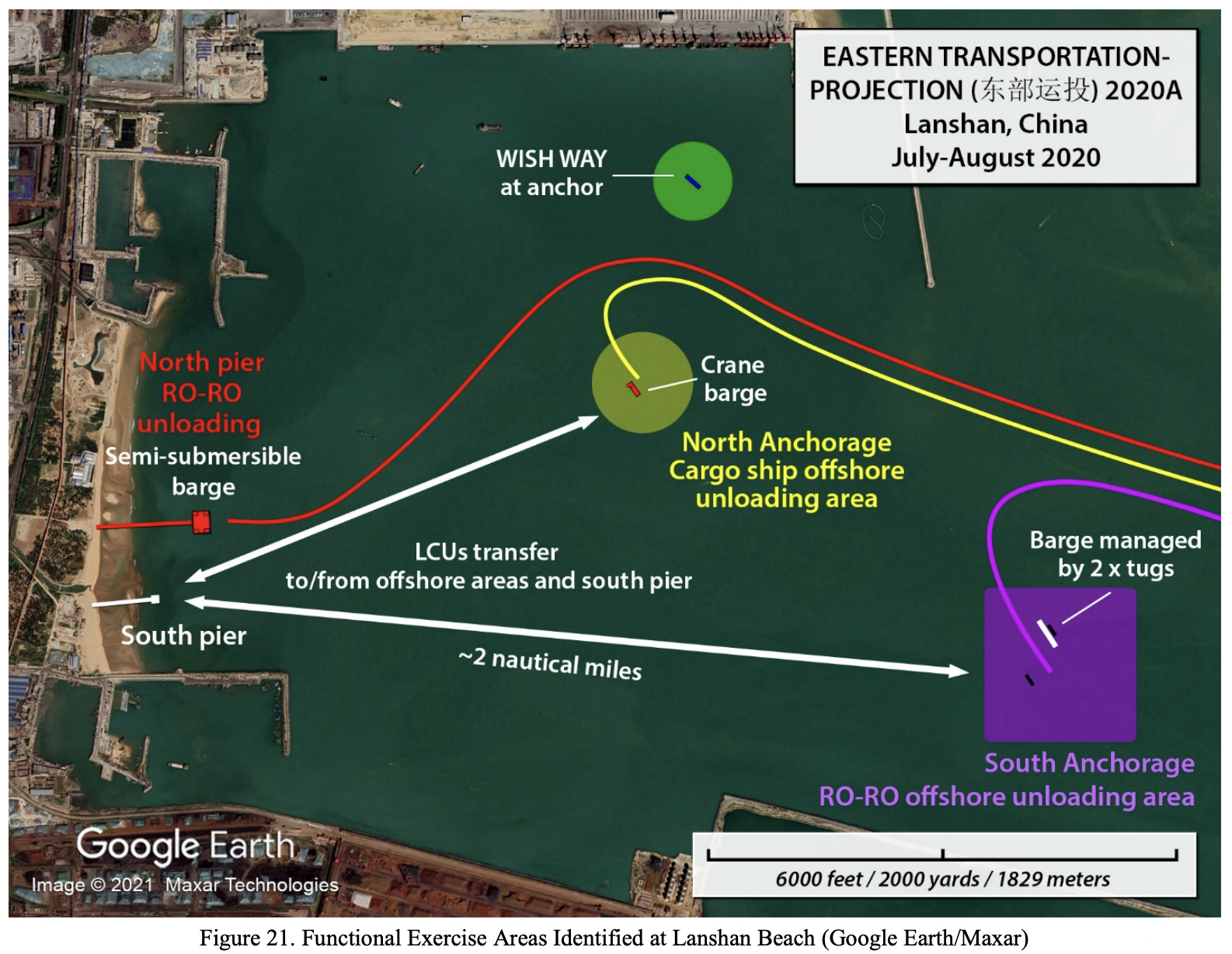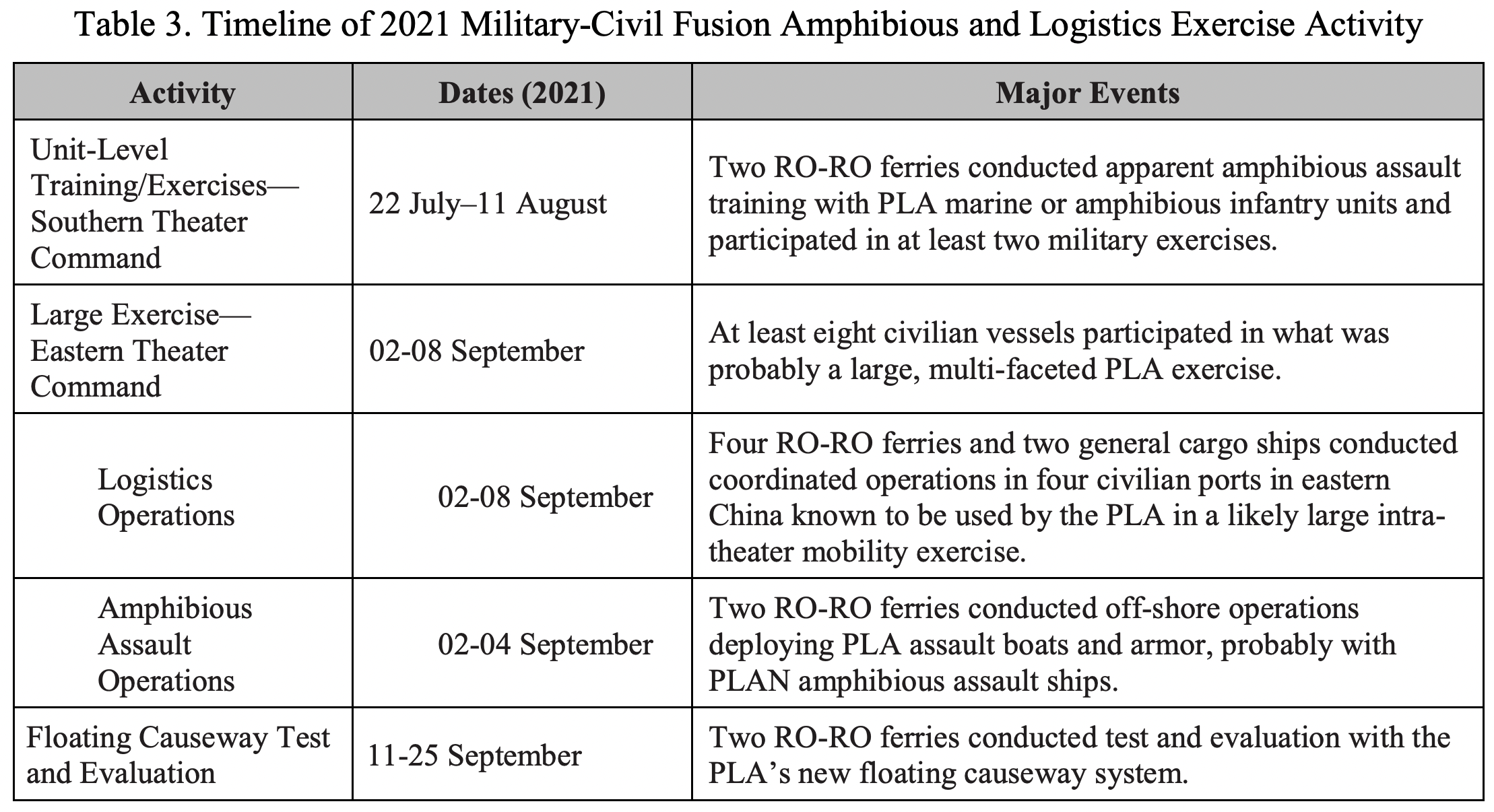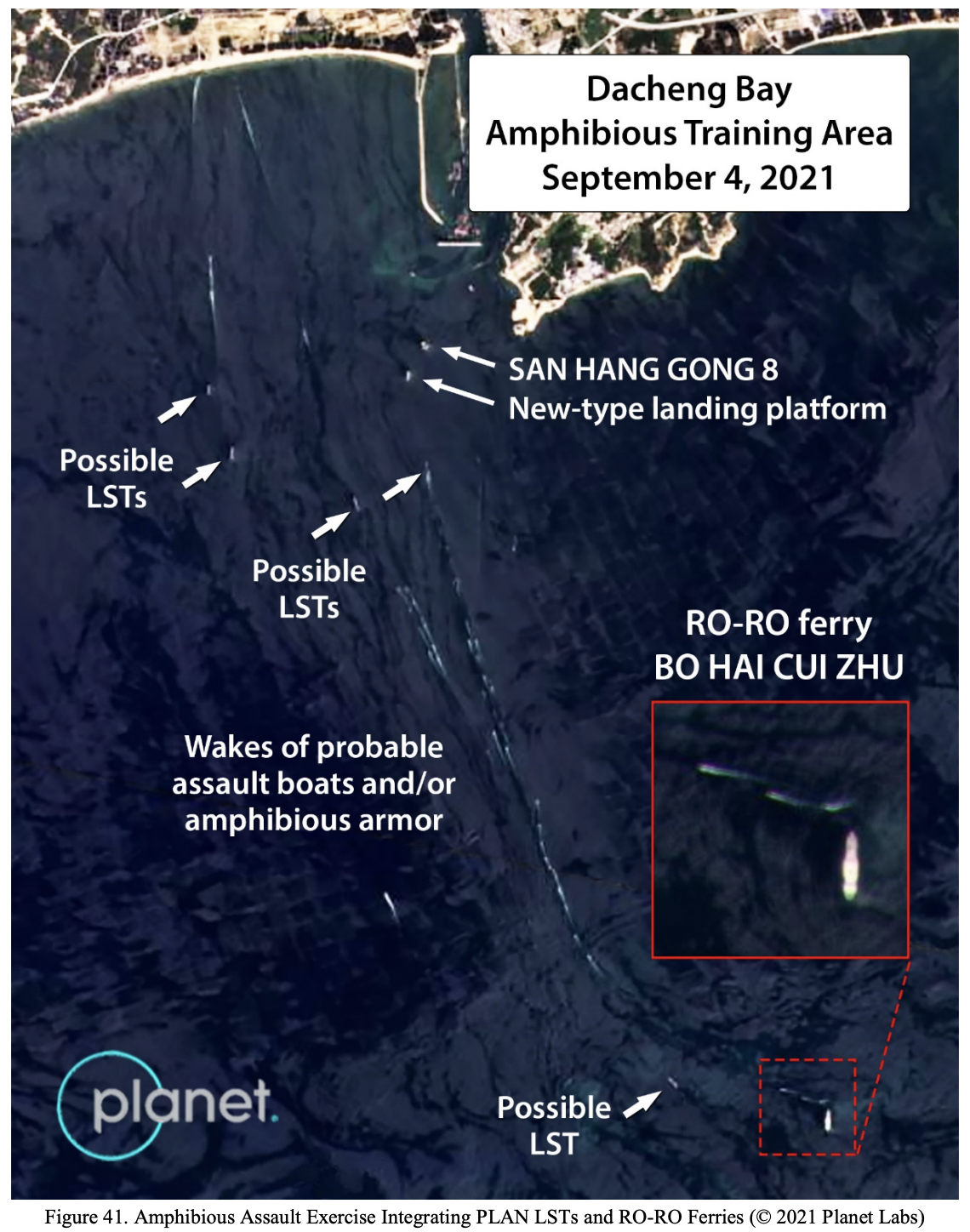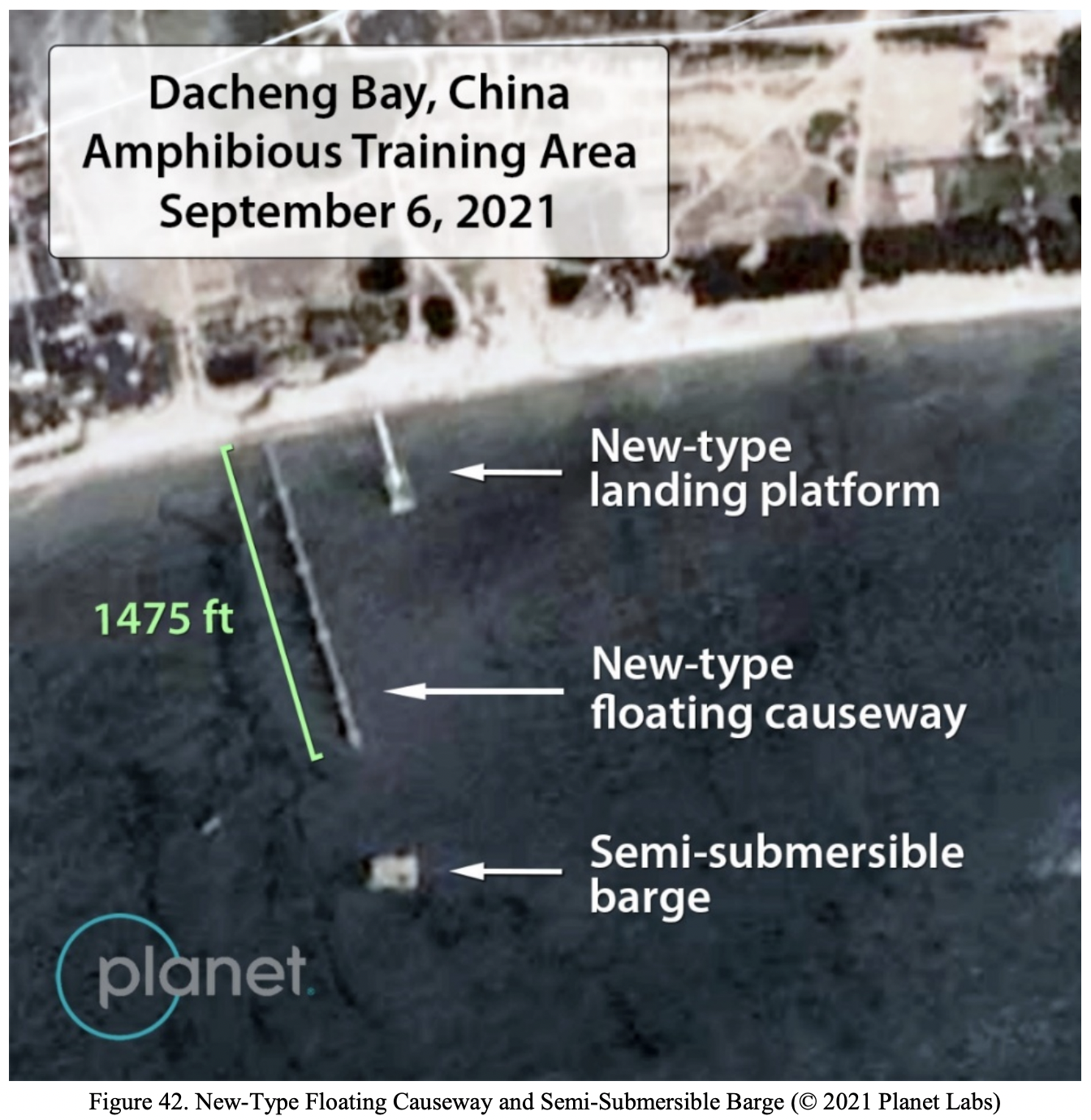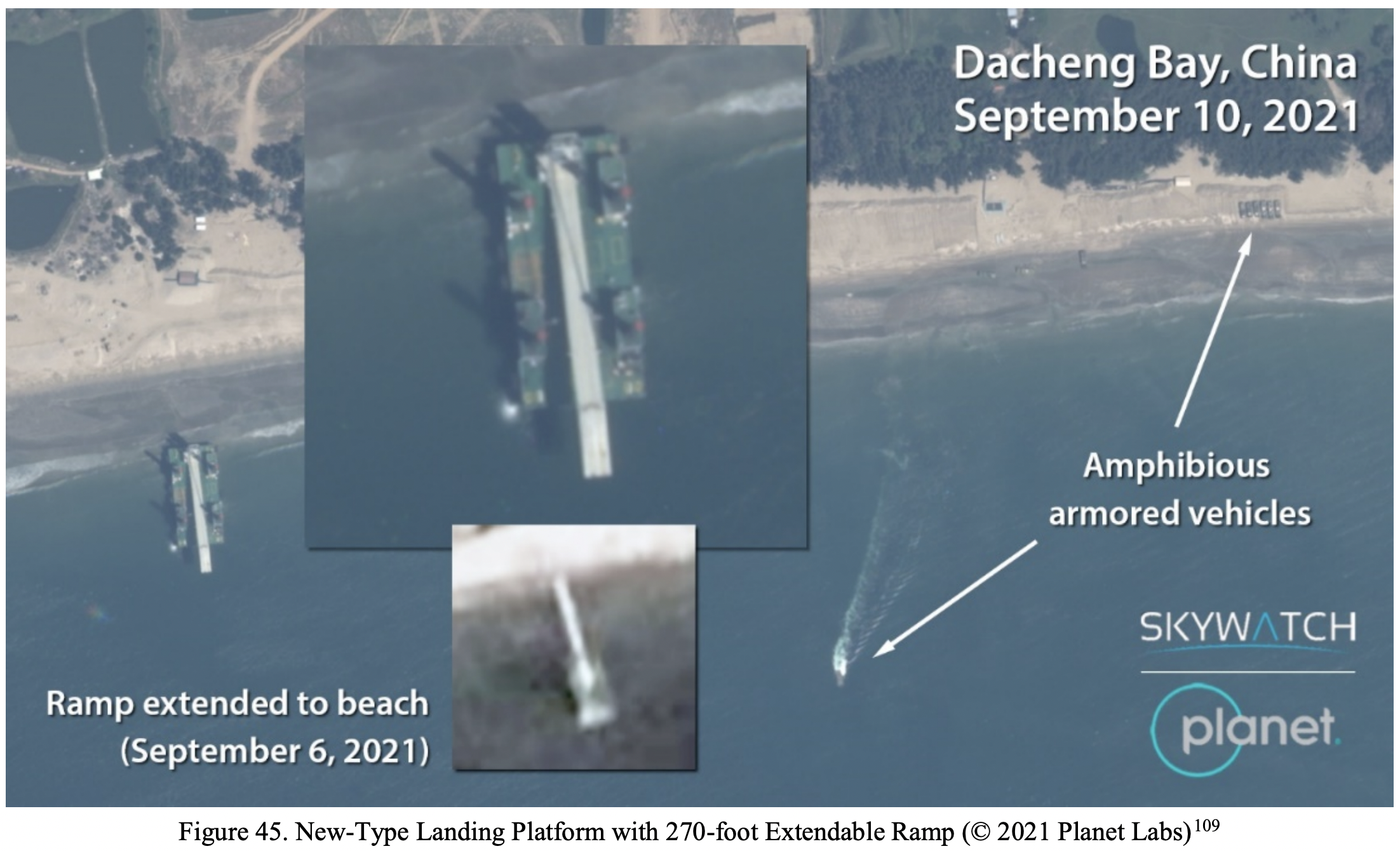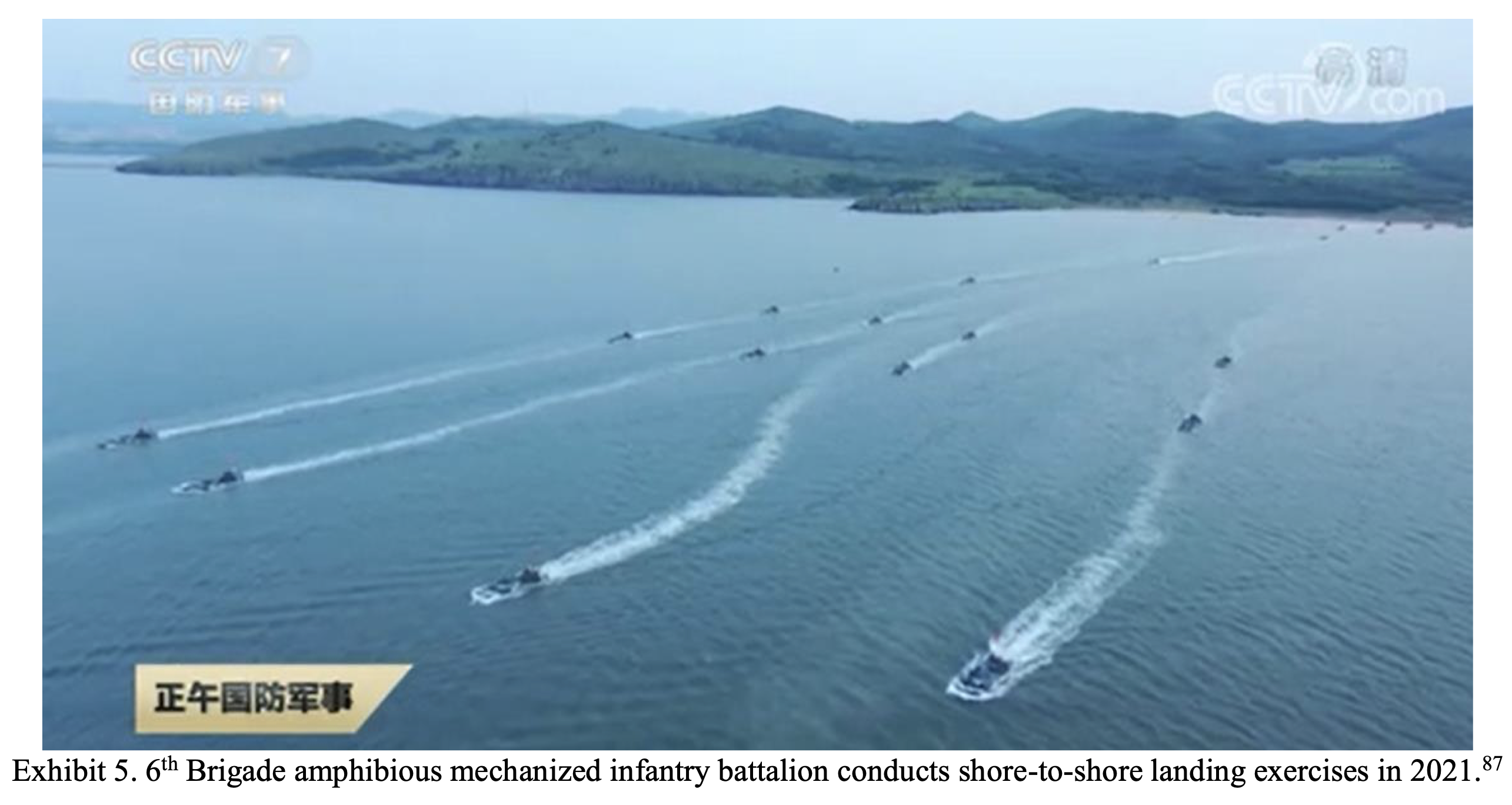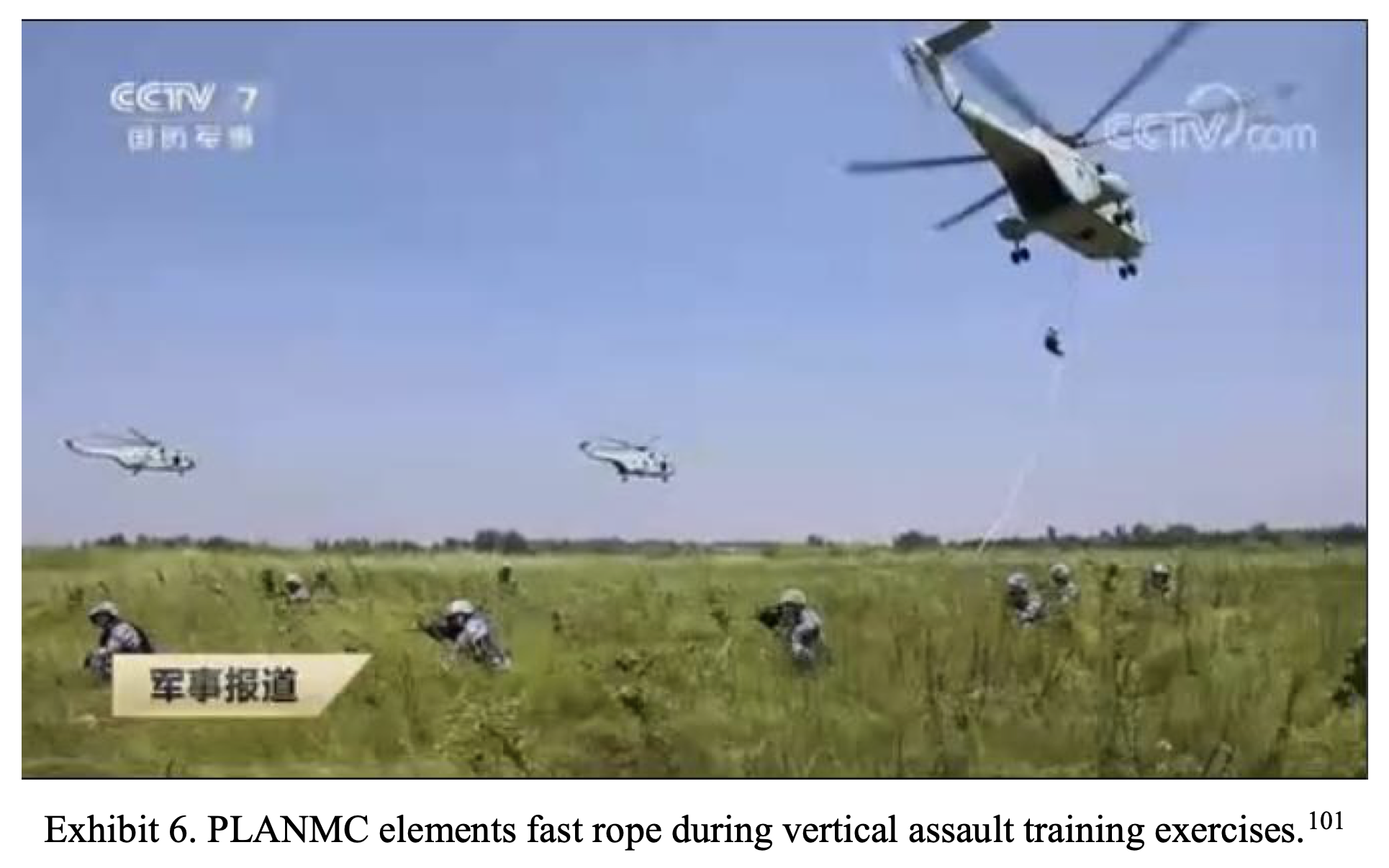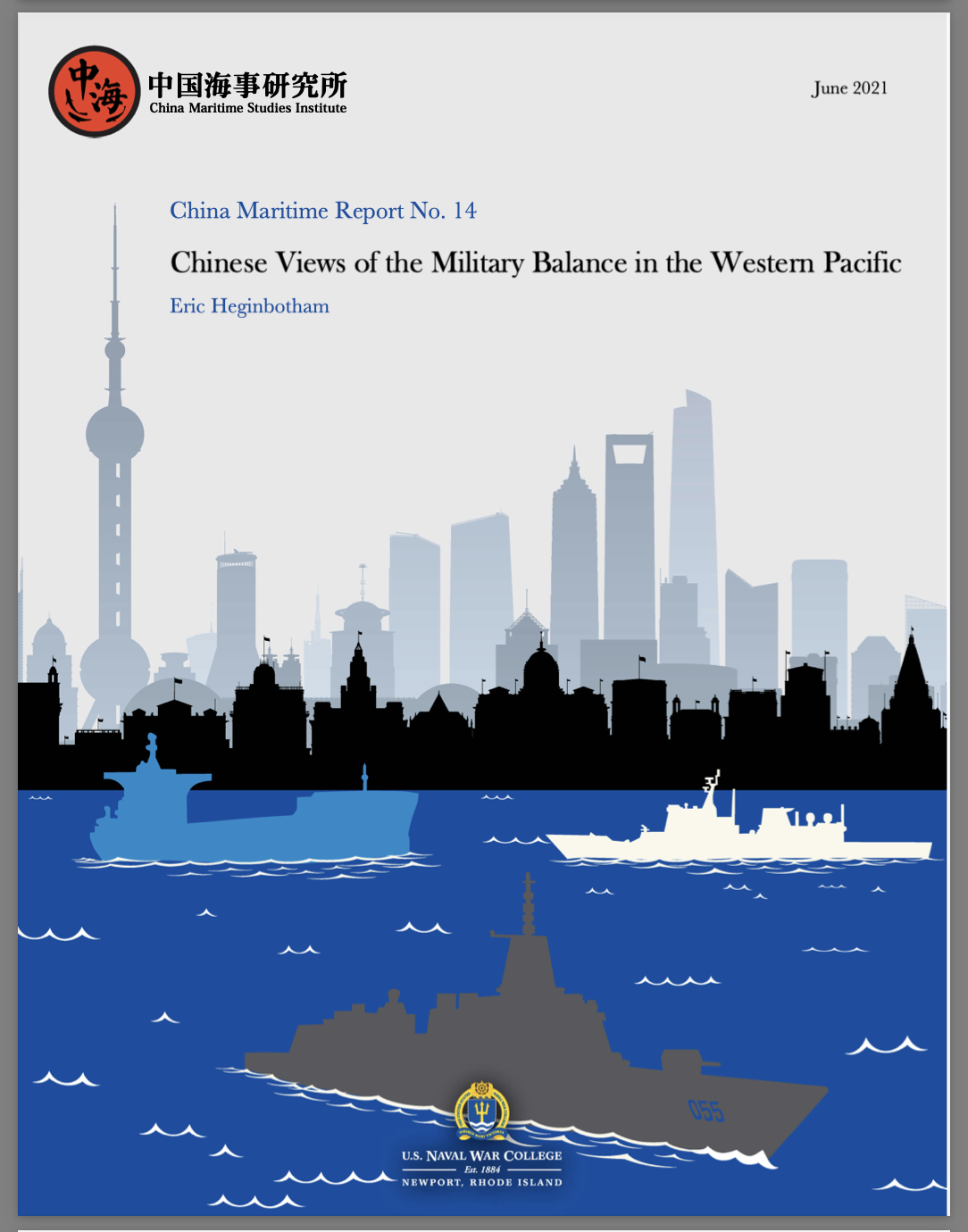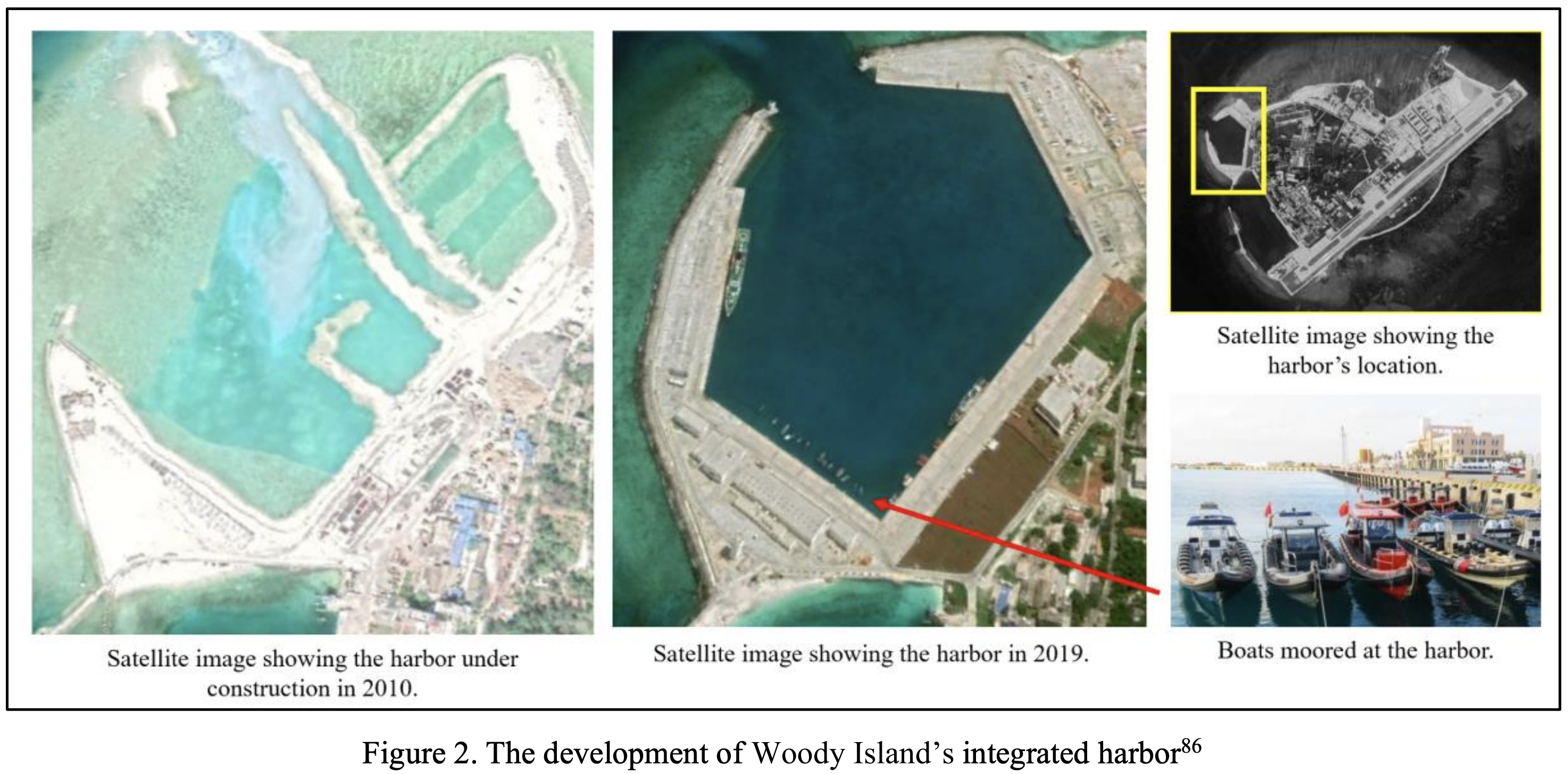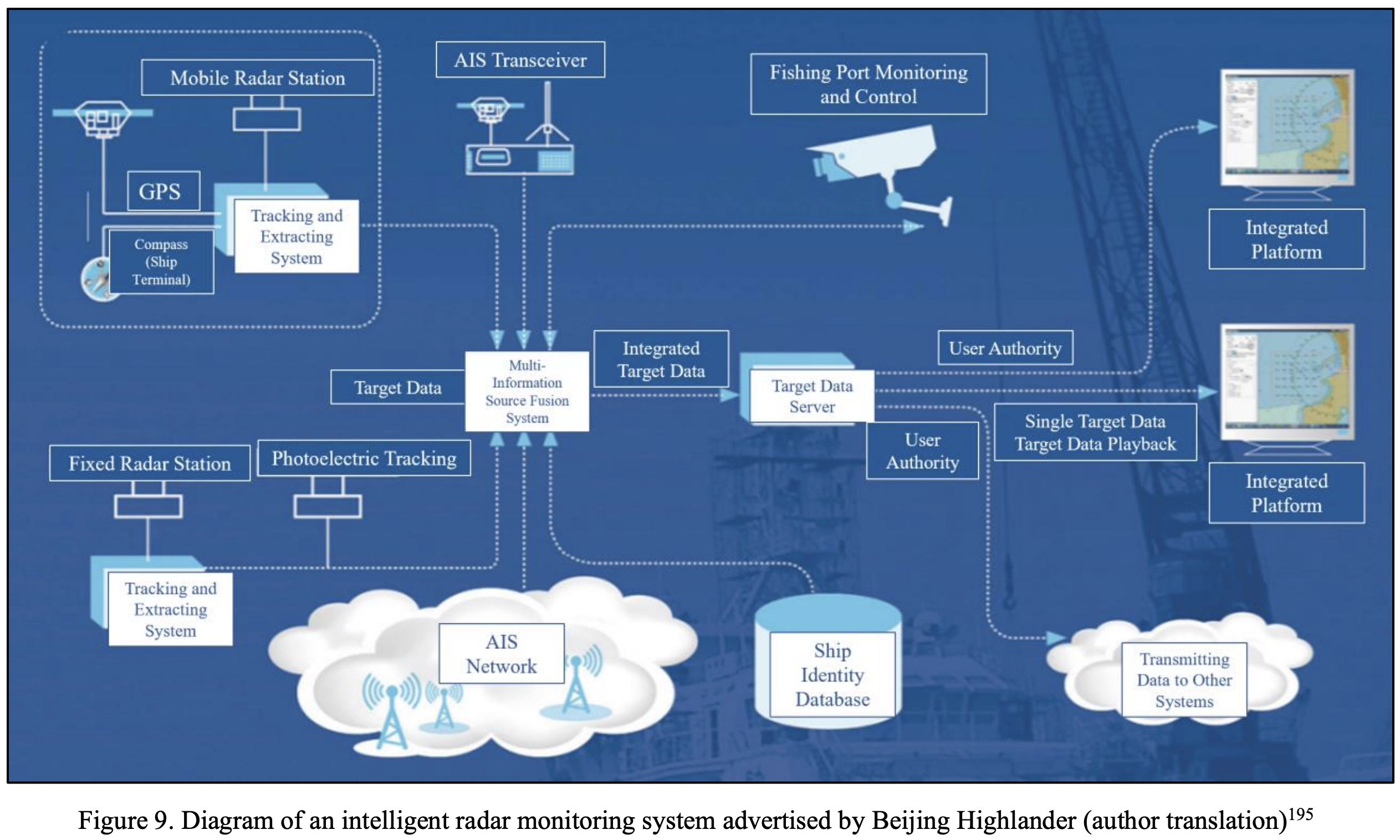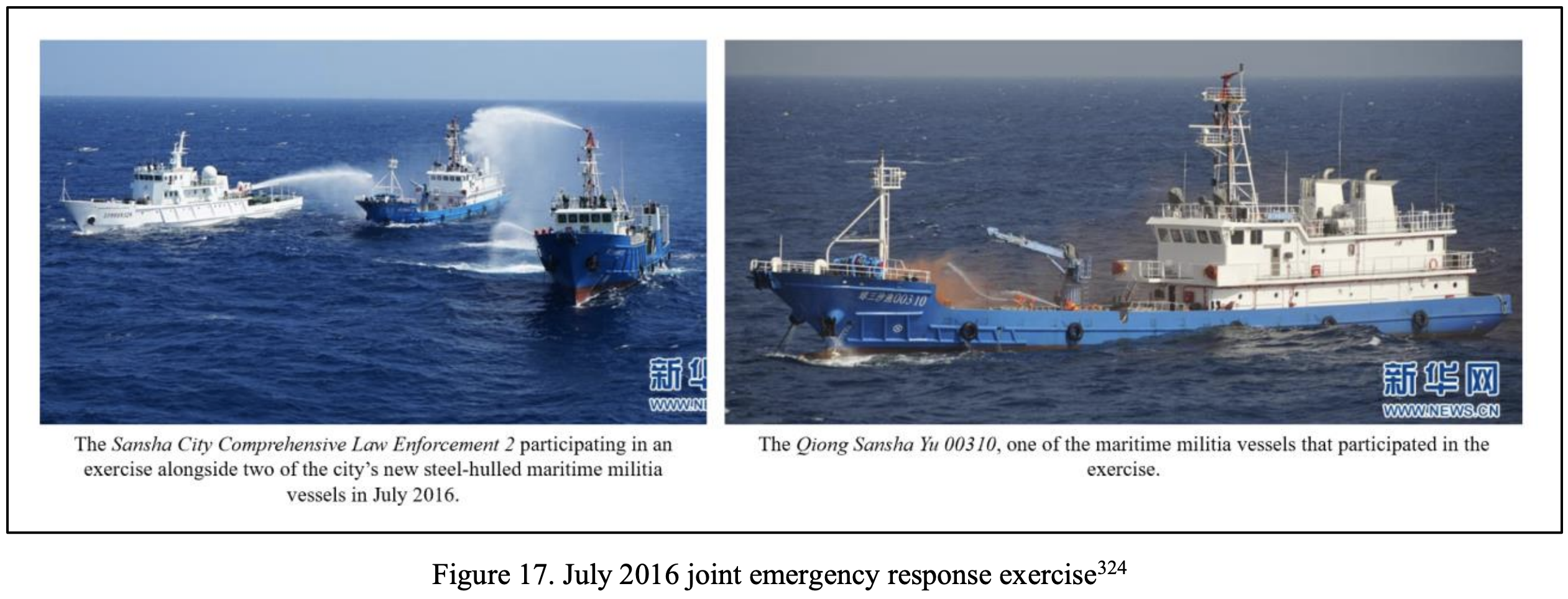CMSI China Maritime Report #20: “The PLA Army Amphibious Force: Missions, Organization, Capabilities, and Training”
Dennis J. Blasko, The PLA Army Amphibious Force: Missions, Organization, Capabilities, and Training, China Maritime Report 20 (Newport, RI: Naval War College China Maritime Studies Institute, April 2022).
This report examines the amphibious forces of the PLA Army and their preparations for large-scale amphibious operations, particularly concerning Taiwan.
About the Author
Dennis J. Blasko is a retired Army Lieutenant Colonel with 23 years of service as a Military Intelligence Officer and Foreign Area Officer specializing in China. He was an Army Attaché in Beijing and Hong Kong from 1992–96. He served in infantry units in Germany, Italy, and Korea and in Washington at the Defense Intelligence Agency, Headquarters Department of the Army (Office of Special Operations), and the National Defense University War Gaming and Simulation Center. Blasko is a graduate of the United States Military Academy and the Naval Postgraduate School. He has written numerous articles and chapters on the Chinese military, along with the book The Chinese Army Today: Tradition and Transformation for the 21st Century, second edition (Routledge, 2012).
Summary
The PLA Army’s (PLAA) amphibious units would serve as the core of any joint force charged with invading Taiwan. As a result of the 2017 reforms, the PLAA now possesses six amphibious combined arms brigades distributed across three group armies (the 72nd, 73rd, and 74th). During a cross-strait invasion, these brigades would likely receive support from other elements of the group armies to which they belong. This could include fire support, air defense, air transport, aerial fire support, and electronic warfare/cyber-attack. Due to its large composition of two-year conscripts, the PLAA amphibious force has traditionally spent the first four months of every year developing basic individual and team skills, although a recent shift to a twice-a-year conscription cycle could allow for more complex training throughout the year. An analysis of the available reporting on 2021 training events indicates that amphibious training occurs frequently from March to October but mostly involves units at or below the battalion level. Despite efforts to bolster the PLAA’s amphibious capabilities, the force currently lacks the capacity to execute a large-scale assault on Taiwan.
Introduction
One of the most important missions assigned to the People’s Liberation Army Army (PLAA) is to provide forces equipped and trained to enhance China’s military posture to deter further steps toward Taiwan independence. All four services, the PLAA, PLA Navy (PLAN), PLA Air Force (PLAAF), and PLA Rocket Force (PLARF), plus the Strategic Support Force and Joint Logistic Support Force, have a role in this effort. If deterrence fails, one military option available to the senior Chinese Communist Party (CCP) leadership is to order the PLA to conduct an extremely difficult and complex operation known as a joint island landing campaign, which would be supported by a joint firepower campaign. Although a traditional over-the-beach amphibious landing likely will not be the first military course of action to be undertaken in a campaign directed against Taiwan, the PLA is clearly preparing for this possibility should other options fail.
The core of the PLAA’s contribution to the Taiwan deterrence and warfighting missions resides in six amphibious combined arms brigades (ACAB) assigned, two each, to the three group armies stationed closest to Taiwan in the Eastern and Southern Theater Commands (TC). Reforms undertaken since 2017, including increasing the capabilities and capacities of PLAA helicopter units and special operations forces (SOF), long-range multiple rocket launchers and air defense weapons, and non-kinetic electronic warfare and cyber-attack units, have greatly expanded the options available to PLAA commanders to conduct joint island landing and joint firepower campaigns.
If ordered to conduct operations against Taiwan or its offshore islands, the six amphibious combined arms brigades will work in concert with elements of their parent group armies and theater commands in an operation that likely will be reinforced by additional Army units from outside the region. Any PLAA action against Taiwan will be coordinated with units from the other services and forces and will also involve militia forces and civilian assets in support. The dispersion of forces in peacetime, however, will require days, if not weeks, to move and assemble units within striking range of Taiwan and prepare them for launching an assault.
Once these forces are ashore, Taiwan’s topography is not optimal for rapid, large-scale offensive, mechanized movements. Only a few beaches along its west coast are suitable for amphibious landing and behind them the terrain soon becomes mountainous and checkered with rice paddies and urban sprawl. Given the restrictions imposed by the terrain, the PLA leadership perhaps sought to modernize PLAA capabilities, as well as capabilities in the other services, to shift the decisive phase of a joint island landing campaign from a traditional over-the-beach amphibious assault followed by a mechanized ground movement inland to a series of airborne (parachute) or airmobile (helicopter) assault operations to seize ports of entry on the coast, airfields, and other key terrain/objectives closer to the center of gravity of Taiwan’s defenses to allow for the rapid insertion of second-echelon follow-on forces by sea and air.1 Nonetheless, a large-scale assault by multiple amphibious combined arms brigades remains a major component of China’s deterrence posture and any joint landing operation.2
This report first addresses the current status of the PLAA’s amphibious combined arms brigades and the support they are likely to receive from their brother Army units. It then discusses training and examines PLAA amphibious and sea-transport exercises and drills conducted in 2021 involving both amphibious and non-amphibious PLAA units. This analysis is consistent with, and supports, the U.S. Department of Defense’s assessment in 2020 and 2021 that
“Both PLAA and PLANMC [Marine Corps] units equipped for amphibious operations conduct regular company- to battalion-level amphibious training exercises, and the PLA continues to integrate aerial insertion training into larger exercises… The PLA rarely conducts amphibious exercises involving echelons above a battalion, although both PLAA and PLANMC units have emphasized the development of combined-arms battalion formations since 2012.3” … … …
PREVIOUS STUDIES IN THIS CMSI SERIES:
China Maritime Reports are short, focused analyses of topics related to China’s rise as a maritime power. Written by members of the China Maritime Studies Institute (CMSI) and other experts, they cover topics as diverse as China’s maritime militia, overseas port development, and amphibious warfare.
Cristina L. Garafola is an associate policy researcher at the RAND Corporation. Her research focuses on the ramifications of China’s rise for its global status, particularly with respect to defense issues, China’s influence on regional actors, and implications for the United States. Garafola served in the Office of the Secretary of Defense from 2017 to 2019, where she focused on National Defense Strategy and Indo-Pacific strategy implementation. She has also worked at the Department of the Treasury, the Center for Strategic and International Studies, and the Department of State. She is the co-author of the book 70 Years of the People’s Liberation Army Air Force (2021), published by the China Aerospace Studies Institute. Her work has been published by RAND and in Asian Security, the Journal of Strategic Studies, War on the Rocks, and the Jamestown Foundation’s China Brief. Garafola holds an M.A. in China studies from the Johns Hopkins School of Advanced International Studies (SAIS), a graduate certificate from the Hopkins-Nanjing Center for Chinese and American Studies, and a B.A. in international relations and Chinese from Hamilton College. She speaks Chinese.
CLICK HERE TO READ A CURATED COMPILATION OF CRISTINA GARAFOLA’S PUBLICATIONS.
In May 2018, the People’s Liberation Army (PLA) announced a major new milestone for its Airborne Corps (空降兵): Chinese paratroopers made their inaugural jump from the Y-20, the country’s first indigenously-built aircraft in its strategic airlift fleet. In the same exercise, the Corps, which is part of the PLA Air Force (PLAAF), completed its first heavy equipment drop from the new aircraft—marking another important achievement in its modernization.1
Despite these developments and other recent modernization efforts underway within the airborne forces, the Airborne Corps’ potential role in a cross-strait invasion has received relatively little attention compared to the development of key ground and naval invasion forces.2 Lack of focus in the past on the capability of airborne units may stem from the extreme capacity limitations of the PLA’s strategic airlift forces, which restricted the PLA’s ability to deploy significant quantities of airborne troops across the strait. However, the 2018 exercise and other recent milestones presage a potentially much more active and significant role for the Airborne Corps in future cross-strait operations.
In recent years, the PLA Airborne Corps has undergone significant reorganization and modernization to improve capabilities relevant for cross-strait operations. The Corps also appears to be increasing its training on complex topics, including in combined arms and joint contexts. However, like the PLA writ large and the PLAAF in particular, the Airborne Corps suffers from a lack of combat experience. It has not conducted combat operations abroad, but rather has been tasked to support the regime during periods of domestic turmoil or for domestic humanitarian assistance and disaster relief (HA/DR) operations. Key questions also remain regarding the Corps’ ability to integrate with other PLA units and conduct operations in complex or degraded environments, as well as the PLAAF’s broader ability to secure the command of the air needed to enable airborne troops to land on Taiwan.
This report chronicles the changing capabilities of the PLA Airborne Corps over the past decade and provides a foundation for assessing the Corps’ role in a cross-strait invasion. It comprises four main sections. Section one briefly summarizes the force structure of the Corps. Section two reviews the Airborne Corps’ stated roles and missions in a joint island landing campaign. Section three examines recent efforts to strengthen the Corps’ ability to conduct operations relevant to a cross-strait invasion. Section four discusses ongoing challenges that the PLA Airborne Corps must overcome to effectively perform large-scale operations of this kind. The report concludes with a summary of main findings and a roadmap for future research on this topic. … … …
Conclusions and Roadmap for Future Research
The Airborne Corps is expected to support a cross-strait invasion by penetrating behind enemy lines. During the JILC, the Corps’ role would be to conduct paradrops or landing operations onto Taiwan, facilitated by PLAAF aircraft. Once on island, airborne forces are expected to seize and hold terrain and conduct a variety of operations that support the broader invasion. In recent years, the Corps has reorganized to improve its capability for mechanized maneuver and assault, leveraging the PLAAF’s larger inventories of transport aircraft, particularly the Y-20; improved the sophistication of its training at home; and gleaned insights from abroad via training with foreign militaries, while also supporting the CCP’s and PLA’s broader diplomacy efforts.
That said, key questions remain regarding the extent to which the Corps has solved potential challenges to its ability to successfully conduct airborne operations. These include effectively integrating with similar ground force and marine units, which have overlapping roles; carrying out operations in complex or degraded environments; overcoming the Corps’ lack of relevant combat experience; and delivering sufficient air support and successfully suppressing enemy fires to escort vulnerable transport aircraft behind enemy lines.
To address these gaps, future research can identify the combined arms and joint exercises in which the Corps participates and assess the frequency and complexity of those exercises. Changes to the types of aircraft or helicopter forces from which they operate may provide indications of evolving operational concepts. Also, overseas exchanges and training may offer additional insights into the Corps’ evolving capabilities and focus areas for improvement.
Finally, while this report reviews substantial evidence that the PLA expects its airborne forces to support cross-strait operations, some caution may be warranted.80 Historically, large-scale airborne operations in highly contested environments resulted in significant casualties to airborne units. Risks to airborne forces in modern warfare have only grown; capable opponents today can pose a wide array of threats to airborne forces, as well as to the transport aircraft supporting them.81 The opportunity costs of deploying airborne forces into high-end conflict scenarios—particularly if air dropped—may therefore be significant, given that transport aircraft can perform an array of other valuable missions. While there is no indication that the PLA is radically rethinking roles for the Airborne Corps, a 2020 commentary by a PLAAF Command Academy researcher took an expansive view of the Corps’ future roles, describing the PLA’s airborne force as “strategic fists” that can not only support major conflicts central to a country’s national security, but also to “defend national interests and expand [the country’s] national security space on a global scale.”82 It is possible that the PLA will increasingly seek to leverage airborne forces for a broader array of operations farther afield and in less contested environments.
About the Authors
John Chen is Chief of Data Solutions and a Lead Analyst at Exovera’s Center for Intelligence Research and Analysis, where he works on foreign policy, national security, and S&T issues using Chinese-language sources. He is also a Nonresident Fellow at the Atlantic Council’s Global China Hub. He holds degrees from Dartmouth College and Georgetown University.
Joel Wuthnow is a senior research fellow in the Center for the Study of Chinese Military Affairs within the Institute for National for Strategic Studies (INSS) at the U.S. National Defense University. His research areas include Chinese foreign and security policy, Chinese military affairs, U.S.-China relations, and strategic developments in East Asia. In addition to his duties in INSS, he also serves as an adjunct professor in the Edmund A. Walsh School of Foreign Service at Georgetown University. Click here to read a curated compilation with summaries of Dr. Wuthnow’s major published works.
Summary
PLA special operations forces (SOF) would likely play important supporting roles in an amphibious assault on Taiwan. Their capabilities and training are geared towards several missions undertaken during the preparatory and main assault phases of the landing, including infiltration via special mission craft and helicopter, reconnaissance and targeting, obstacle clearance, strikes and raids, and extraction missions. While PLA SOF have made progress in recent years, several longstanding challenges could affect their performance in an island landing: integrating advanced special mission equipment for complex and dangerous missions, coordinating their operations with non-SOF supporting and supported forces, and overcoming the Chinese military’s penchant for centralized command. Even if PLA SOF are only partially effective, however, their support to the main assault force could diminish Taiwan’s ability to defend itself from a large-scale invasion.
Introduction
One important but sometimes overlooked factor that will influence the success of a People’s Liberation Army (PLA) attempt to seize Taiwan is special operations forces (SOF) support to the main assault force.1 Special operations have contributed to amphibious assaults in several modern campaigns, including Normandy (1944), the Falkland Islands (1982), and Grenada (1983). U.S. joint doctrine for amphibious operations continues to assign SOF multiple roles, including military information support, civil-military operations, foreign humanitarian assistance, special reconnaissance, direct action, and preparation of the environment.2 During the preparatory and primary landing phases of a Taiwan invasion, and even during a potential “mop up” campaign against resistance fighters, the PLA would likely utilize SOF for similar purposes.3 Depending on their performance, these forces could enable or frustrate the operations of conventional PLA units, or perhaps have no effect at all.
This report addresses the potential role of PLA SOF in a Taiwan campaign from three perspectives.4 First is doctrine. By analyzing authoritative PLA publications, including the Lectures on the Science of Special Operations, we find that PLA SOF are assigned three roles, including a primary role in special reconnaissance and secondary roles in strikes/raids on key targets and in information operations. Second is force structure and capabilities. The PLA Navy (PLAN), PLA Air Force (PLAAF), PLA Army (PLAA), and People’s Armed Police (PAP) all possess SOF relevant to a Taiwan contingency, including some forces that have expanded in recent years. The PLA has also acquired special mission equipment relevant to amphibious missions, such as underwater personnel delivery systems. Third is training. Based on PLA print and television media reports, PLA SOF have focused on squad-level and individual skills training, but there is also evidence of SOF involvement in larger combined-arms exercises. However, we found that joint training is limited, and there is almost no open-source evidence of SOF actively preparing for information operations.
The PLA has worked steadily over the last decade to ready SOF for an island landing scenario by refining doctrine, bolstering capabilities, and improving training. However, there are several variables that will influence these units’ performance, including their technical proficiency and potential greater use of unmanned systems, which could replace humans in some roles but increase technical proficiency requirements; degree of jointness, including the need for larger and more frequent exercises with non-SOF units and continued reforms to joint command structures at and below the theater level; and the degree to which commanders try to micromanage SOF activities on the battlefield, which could lead to suboptimal results if those forces hesitate to act without explicit approval. The Taiwan and U.S. defense establishments should work to evaluate these challenges and weaknesses and determine whether plans for Taiwan’s defense adequately consider PLA SOF. … … …
Conclusion
… While not discussed in Chinese doctrinal sources, it is also likely that PAP or other special forces would remain on Taiwan following a successful landing to conduct counterinsurgency-type missions. One area where doctrine may still be ahead of practice is information operations. It is unclear from open-source reports that SOF are preparing for on-island propaganda work, or are training with other relevant PLA units, including the SSF, for this mission.
While PLA SOF have made progress in recent years, several variables will influence their performance in an island landing. One is whether SOF can field and integrate better special mission equipment for complex and dangerous missions. While China’s defense industry undoubtedly continues to improve manned special mission equipment for SOF, researchers have also stressed the utility of unmanned undersea and aerial vehicles for dangerous special operations like mine and obstacle clearing.91 Coordination and effective application of unmanned systems will call for more demanding training and recruitment requirements within PLA SOF.
Another variable is whether SOF can effectively coordinate their operations with non-SOF supporting and supported forces. How much coordination is necessary would likely vary by unit composition and mission type. SOF units with a diverse range of organic capabilities, specialized hardware, and dedicated support units may require less joint coordination than units tasked to accomplish special operations in which the mission rather than the unit is defined as “special.” Elite commando units like the U.S. Navy’s SEAL Team Six with dedicated transport and intelligence support units may require little interaction with main landing forces, but others, such as brigade-sized army units that would deploy alongside and directly support the main landing forces, may need to coordinate more extensively. In the latter case, which appears to describe the majority of the PLA’s SOF units, the lack of permanent joint structures below the theater level could diminish the effectiveness of joint operations involving special forces, potentially leading to catastrophic results similar to the failed U.S. hostage rescue attempt in Iran during Operation Eagle Claw.92 Moreover, some relevant units, including from the SSF, PAP, and Airborne Corps, are outside the theater structure, leading to questions about joint command even at that level. Evidence that these potential shortcomings are being addressed would be inclusion of Airborne Corps and PAP SOF in theater command-led exercises; the establishment of permanent lower-level joint commands or liaison arrangements; and real-world operations, perhaps in counter-terrorism missions within China and farther from home, that would require SOF to learn lessons and adapt.
Chinese special operations would also have to reconcile the imperative for small, clandestine operations behind enemy lines with a desire for unified command under the joint command construct. Generally, there is a tension between the Leninist emphasis on centralization and the need to grant autonomy to lower PLA commanders. This could be especially problematic in special operations: centralized command could lead to poor performance if small units fail to act due to the lack of explicit authorization, or if they are forced to maintain radio communications and thus reveal their positions to the enemy. Evidence from training or updated doctrine could offer signs of whether SOF teams are given adequate autonomy in the field.
Nevertheless, even partially effective special operations could diminish Taiwan’s defenses and thus should be explicitly addressed in defensive concepts. Taiwan’s articulation of a more “asymmetric and innovative” way of defeating an island landing, which has been discussed in recent years under the “overall defense concept” label, should explicitly acknowledge the threat posed by Chinese special operations forces preceding and during all phases of an island landing and determine whether additional changes to tactics and capabilities are needed.93 Those approaches should also identify PLA weaknesses, such as lack of technical proficiency, limited jointness, and potential overreliance on radio communications for command and control, and tailor responses accordingly. It is also worth exploring whether, and how, U.S. SOF may work with their Taiwan counterparts to evaluate the dangers posed by PLA SOF, share best practices, and conduct joint training.94
Tom Fox, The PLA Army’s New Helicopters: An “Easy Button” for Crossing the Taiwan Strait? China Maritime Report 17 (Newport, RI: Naval War College China Maritime Studies Institute, December 2021).
In this report, U.S. Army Major Tom Fox examines the feasibility of a PLA Army air assault across the Taiwan Strait.
About the Author
Maj. Tom Fox is an aviation officer in the U.S. Army. From 2018 to 2021, he served as an assistant professor of international affairs and Chinese politics in the Department of Social Sciences at West Point. He holds a BSFS from Georgetown University and an MPP from the Harvard Kennedy School. The opinions expressed here are the author’s alone and do not represent the U.S. Military Academy, U.S. Army, or Department of Defense. The author would like to extend a special thanks to Dennis Blasko, Kim Fassler, Joel Wuthnow, and John Chen for their helpful guidance in the early stages of research for this project. Nonetheless, the views herein are the author’s alone, and that applies to any errors of fact, omission, or interpretation.
Summary
This report examines the potential roles and missions of the People’s Liberation Army’s (PLA) new rotary wing capabilities in a cross-strait invasion. Looking specifically at the helicopter units of the PLA Army (PLAA), it discusses two possible scenarios in which these forces could serve as the main thrust in a campaign to seize control of Taiwan. In the first scenario, the PLAA would use nearly all of its rotary wing inventory simultaneously to overwhelm Taiwan’s defenses and quickly convince the country’s political leadership to surrender. In a second “unconventional” scenario, the PLAA would risk the destruction of older helicopters in order to launch a sudden attack against the island, thereby achieving the element of surprise while saving its most capable platforms for lengthy follow-on operations to fully subdue the island. Based on analysis of the scale, complexity, and frequency of recent PLAA exercises, this report argues that China is at best a decade away from having the ability to seize Taiwan by either approach.
Introduction
China watchers have long paid close attention to the People’s Liberation Army’s (PLA) modernization efforts, which have gone on more or less continuously since Deng Xiaoping included them as one of his Four Modernizations. While much academic and media coverage of this process has understandably focused on high dollar and high technology platforms like fighter jets, submarines, and aircraft carriers, the PLA has also made significant investments in updating its rotary wing capabilities. Not only has the PLA developed and acquired more different types of advanced helicopters, but it has also bought more of them, evolved their organizational structure, and trained their pilots and aircrews to feature these capabilities more prominently. Due to the historical centrality of Taiwan “reunification” and recently increased cross-strait tensions, these developments beg the big question: how might these new helicopters help the PLA invade Taiwan?
This report seeks to answer that question, focusing specifically on the rotary wing capabilities of the PLA Army (PLAA). It proceeds in four parts. Part one explores the new rotary wing capabilities by analyzing the helicopters themselves, the organizations fielding them, and the training and doctrine for their employment. Part two focuses on scenario development. It presents two possible approaches that the PLAA might use to leverage these new capabilities in a Taiwan invasion. Part three provides an assessment of the PLAA’s current readiness to play the roles envisioned in the two scenarios. Part four turns to Taiwan’s options for responding to these developments and how best to counter the PLA’s increased capabilities. This report focuses on changes within the PLAA’s Aviation Corps. While rotary wing capability development has also improved the PLA Navy’s (PLAN) options for anti-submarine warfare and amphibious operations, the bulk of significant change has occurred within the PLAA. With these new capabilities, a massive cross-strait air assault may look like an “easy button” to avoid the notorious difficulty of amphibious operations. This report argues that the PLAA currently lacks the capabilities needed to serve this function in a cross-strait invasion scenario. … … …
Conclusion: Not an “Easy Button,” Yet
The PLAA has developed significant rotary wing capabilities in the last decade, and it appears poised to make even greater gains in the next decade judging by its continued fielding of new helicopters and commitment to training for the complexity of modern battlefields. While it takes a long time to build pilot, aircrew, and unit proficiency and even longer to integrate that capability with ground brethren and the joint force, PLA watchers should continue to closely follow developments in this space. In theory, they could eventually become a game-changer for the military balance across the strait, but they are not that yet. The PLA might decide to test these new capabilities on a softer target like Kinmen or Matsu islands,51 although that comes with significant political risk, discussion of which is beyond the scope of this analysis. From solely a military perspective, those islands are much harder for Taiwan to defend due to the extremely favorable geography (small size and proximity to the mainland) for the PLA.
In the final analysis, all cross-strait military scenarios depend significantly on the political circumstances in which they would play out. Air assault operations to cross the Taiwan Strait represent a new development and present Taiwan with another challenge for defending the island, but not an immediately pressing one and not an undeterrable one. Nonetheless, as the PLA continues to strengthen these capabilities, the CCP will aim to exploit additional political leverage gained by shifting the military balance further in its favor. While deterrence remains possible now and well into the future, the most important variable to watch is the risk tolerance of CCP leaders for bearing the significant casualties that would accompany any attempts to take Taiwan by force. Air assaults are not an “easy button” for the CCP, but in the next decade they will become a more realistic option with lower costs than an amphibious assault. And it could be a button political circumstances tempt CCP leaders to press.
J. Michael Dahm, Chinese Ferry Tales: The PLA’s Use of Civilian Shipping in Support of Over-the-Shore Logistics, China Maritime Report 16 (Newport, RI: Naval War College China Maritime Studies Institute, November 2021).
Pathbreaking contribution by J. Michael Dahm, a retired U.S. Navy intelligence officer and a senior researcher at the Johns Hopkins University Applied Physics Laboratory. Among his Indo-Pacific assignments, he formerly served as Assistant U.S. Naval Attaché in Beijing—& graciously hosted me & my CMSI colleagues there. Check out the revealing accompanying graphics: 47 figures & 7 tables!
The analyses, perspectives, and opinions expressed in this report are those of the author and do not necessarily reflect those of the U.S. Navy, APL, or APL sponsors.
Summary
The People’s Liberation Army (PLA) has long provided indications it will use civilian shipping in direct support of a cross-strait invasion of Taiwan. To date, however, there has been little effort to gauge the PLA’s actual ability to leverage China’s commercial fleet in the most challenging part of any such campaign—operations over-the-shore. Drawing from ship tracking data, satellite imagery, media reporting, and the writings of PLA experts, this report analyzes recent military-civil fusion exercises and training to assess current capabilities. A PLA exercise in summer 2020 indicates significant developments in the use of new technologies by select Chinese-flagged merchant ships for over-the-shore logistics support to amphibious operations. In 2021, the PLA also demonstrated the use of roll-on/roll-off (RO-RO) ferries as auxiliary landing ships in amphibious exercises and tested a new floating causeway that could be used in a large-scale amphibious operation. Notwithstanding these developments, this report concludes that as of 2021, China’s merchant fleet is unable to provide the amphibious landing capabilities or the maritime logistics in austere or challenging environments necessary to have a significant impact in an amphibious landing operation on Taiwan.
Introduction
The PLA will probably not be able to conduct a successful cross-strait invasion of Taiwan until and unless it masters what the U.S. military calls joint logistics over-the-shore (JLOTS). While “JLOTS” is not a term Chinese military authors typically use, they have nevertheless considered how the PLA should conduct logistical support immediately after a large-scale amphibious assault and have commented on such capabilities the PLA may require. These capabilities include unloading in rudimentary or damaged port facilities; using temporary piers or wharves to offload vehicles and supplies directly to shore; and unloading cargo ships, including RO-RO ships, at-sea and then lightering materiel to a captured port or beachhead.
PLA authors uniformly assert that civilian ships, working closely with the military, will be an integral component of any major cross-sea logistics operation, including over-the-shore operations. In recent years, the PLA has conducted a number of exercises to bolster military-civil fusion (MCF) in amphibious operations. To what extent have these exercises helped develop the JLOTS capabilities needed for a Taiwan invasion?
This report sheds light on this vital question by carefully examining MCF exercises in 2020 and 2021. In the summer of 2020, the PLA’s Joint Logistics Support Force (JLSF) conducted a complex, large-scale maritime logistics exercise in China’s Eastern Theater, the military theater that would be responsible for a cross-strait invasion. Taking place in Lianyungang, Jiangsu province, the exercise— called EASTERN TRANSPORTATION-PROJECTION 2020A—featured the JLSF working closely with a large number of substantial civilian RO-RO ferries, cargo ships, tugs, and construction vessels as well as PLA landing craft in an amphibious logistics exercise that became increasingly complex over two months. While the PLA did not repeat this exercise in the summer of 2021, it did conduct unit-level training in the Southern Theater Command and a large exercise in the Eastern Theater Command. These amphibious exercises appeared to move beyond benign logistics or the deployment of second echelon forces in amphibious landing areas. They saw civilian RO-RO ferries working in concert with larger PLA Navy (PLAN) amphibious assault ships, deploying first echelon forces offshore in beach landing operations. In September 2021, the PLA also tested and evaluated a new floating causeway system, an effort to improve on a modular floating pier showcased in 2020.
This report integrates open-source media reports with ships’ tracking data from automatic identification system (AIS) terminals and commercial satellite imagery to reconstruct the 2020 and 2021 MCF exercises. Based on an in-depth analysis of the events, the report offers the following conclusions about the PLA’s capabilities to conduct amphibious operations using civilian ships as a core component of a large-scale amphibious operation:
- As of 2021, the PLA and its reserve civilian merchant fleet are probably unable to provide significant amphibious landing capabilities or the maritime logistics in austere or challenging environments necessary to support a large-scale, cross-strait invasion of Taiwan.
- The PLA’s use of civilian shipping in amphibious exercises appears to be limited to select ships demonstrating nascent capabilities, but not the capacities necessary to support a cross-strait invasion. However, capacities could increase rapidly after initial capabilities are formally adopted and exercise participation expands to a larger number of civilian ships.
- 2020-2021 exercise events appeared to be scripted and focused on establishing procedures and coordination among military units and civilian components.
- The 2020 JLSF exercise featured experimentation with a number of novel logistics capabilities that have been slow to develop and have likely not yet matured probably due to a lack of investment. In a possible change in that trend, 2021 activity saw the introduction of the first new amphibious landing technologies in over fifteen years.
- In most cases, civilian shipping support to amphibious exercises was provided during daylight hours; events were timed for when tides and weather conditions were favorable; many evolutions took place in the sheltered waters of an inner harbor.
- In the 2020 JLSF exercise, there was no evidence of simulated combat conditions during the exercise; no defensive actions (e.g. convoying, escorting, evasion or diversion) were observed. In the 2021 amphibious landing exercises, civilian ferries appeared to be deployed and positioned to mitigate potential threats to these vulnerable ships.
- These 2020-2021 exercises likely provide a baseline for the PLA’s use of civilian shipping to support large-scale amphibious logistics and provide a roadmap for the types of capabilities and capacities the PLA may need for future operations. … … …
Conclusions
As of 2021, the PLA and its reserve civilian merchant fleet are probably unable to provide the maritime logistics in austere or challenging environments necessary to support a cross-strait invasion of Taiwan. Although 2021 exercises employed RO-RO ferries as reserve amphibious landing ships, deploying infantry in assault boats or amphibious armor, this likely represents a very modest augmentation for a potential PLA landing force. Despite concerns that China could bring its vast fleet of merchant ships to bear on an operation to invade Taiwan or conduct some other military operation, there are practical realities that should limit such concerns. The complexity of amphibious operations appears to have limited military-civil fusion to a handful of select ships that provide the PLA with relatively modest capacities.
The apparent increase in civilian ship participation in PLA amphibious exercises may simply reflect the PLA taking advantage of excess RO-RO ferry availability during the COVID-19 pandemic. However, the appearance of new amphibious logistics technologies, probably years in the making, suggests otherwise. The continued integration of civilian ships into PLA operations will be telling, especially as exercise participation extends to ships other than the large Bohai Gulf-based ferries. Once procedures have been established and the PLA has gained some experience integrating civilian vessels into amphibious operations, there may be great potential to rapidly scale up the use of civilian ships in combat support or amphibious logistics roles. The expanding roles for merchant ships in military operations may present challenges for China’s adversaries in terms of detecting, targeting, and countering these civilian vessels.
However, scaling up combat and logistics operations can be a challenge that increases geometrically in complexity as numbers of participating forces and volumes increase. Loading and moving eight civilian ships once is very different from loading and moving eighty ships once or, more likely, coordinating dozens of ships to load and move materiel, equipment, and personnel for days or weeks, all while taking enemy fire. In the 2020 over-the-shore logistics exercise, the landing and unloading operations appear to have been completely unopposed. In the 2021 logistics operations, there was also no evidence observed in the tracks of the ships or satellite imagery that the exercise sought to simulate the presence of an enemy force. No defensive actions (e.g. convoying, escorting, evasion or diversion) were observed. However, based on observations of defensive actions taken in the 2021 landing exercises, the PLA and its merchant support fleet may be changing their mindset about putting these ships in harm’s way.
The appearance of a new floating causeway system and landing platform in 2021 indicates that the PLA is investing in better over-the-shore logistics technologies. These platforms could provide the PLA with significant capabilities and access to beach landing areas with military or civilian ships. That said, Project 019 was initiated in 2001 and heralded by the PLA as a major (if not widely known) project to create a capability for at-sea transfer and unloading of materiel and equipment in austere conditions. Prototype capabilities appeared over a decade later. By 2020, it appeared the PLA was still utilizing those same prototype capabilities in Exercise EASTERN TRANSPORTATION-PROJECTION 2020A. Given these long timelines for development and the challenges the PLA may be experiencing with its new floating causeway system, it is unlikely the PLA will rapidly increase its over-the-shore logistics capability in the next several years.
A group of Chinese military authors affiliated with the PLA’s Military Transportation University and the JLSF Transportation and Projection Bureau provide some insights about the state of PLA over-the-shore logistics capabilities. In January 2020, they wrote that the Chinese military’s “dockless unloading equipment” (无码头卸载装备) is essentially a “technical reserve.” Most of the specialized equipment are prototypes, according to these PLA authors. They observe that dockless unloading equipment is usually kept in storage and seldom used, which provides significant challenges for training and procuring the necessary volume of equipment that might otherwise support large-scale operations. In their critique, they conclude, “[The Chinese] military’s dockless unloading is still in its infancy. There are still many weak links.”121 That January 2020 assessment is likely accurate based on detailed observations of Exercise EASTERN TRANSPORTATION-PROJECTION 2020A and 2021 exercise activity. How those nascent capabilities grow in the coming years should be watched closely.
The 2020 and 2021 exercises integrating civilian shipping, especially large RO-RO ferries, may have provided the PLA and its JLSF with a baseline assessment for where the Chinese military is with regard to large-scale amphibious operations and logistics. The lessons learned from the JLSF’s experience over the summer of 2020 may provide a roadmap for the types of capabilities and capacities the JLSF and the larger PLA joint force may need for future operations. Depending on the PLA’s take-aways, one might expect to see what are probably still prototypes like the floating pier system, the new floating causeway, and the new landing platform go through additional experimentation and exercises, possibly leading to large-scale production of these types of capabilities to support multiple landing points in a Taiwan invasion. Similarly, ad-hoc capabilities like deck barges modified into an at-sea RO-RO unloading platform may evolve into tailored systems with features supporting the unique requirements for loading and unloading military equipment from both naval vessels and civilian ships at-sea.
Despite these seemingly negative critiques of PLA amphibious landing capabilities in general, and over-the-shore, “dockless” logistics capabilities in particular, it would be a mistake to underestimate the ingenuity and tenacity of the PLA. An evaluation of these 2020 and 2021 exercises should be considered in the context of a Chinese approach to problem solving rather than a Western opinion about how amphibious logistics should be done. The PLA’s reserve merchant fleet probably does not currently have the capabilities and capacities to support a disciplined, effective, and efficient amphibious operation with over-the-shore logistics in support of a Taiwan invasion. However, efficiency is not necessarily a prerequisite for success, especially for the PLA.
Clearly, the PLA has started to work through what may be required to support an invasion of Taiwan and how exactly that will be done. The Chinese Communist Party can leverage a national mobilization of maritime shipping on a massive scale and the PLA clearly intends to exploit that capability. Such a mobilization of civilian shipping to support cross-strait operations may be very high risk and could involve extremely high losses. However, there is a certain “quality in quantity.” There are few challenges related to efficiency and attrition that the Chinese military could not simply address with overwhelming mass and a tolerance for loss. Future exercises like those explored in this report merit close scrutiny to provide indications of the trajectory of PLA amphibious and logistics capabilities.
Sources and Methods
This report fuses a variety of publically and commercially available sources to gain detailed insights into often complex military activity and capabilities. Analysis is supported with AIS data from MarineTraffic—Global Ship Tracking Intelligence.122 Google Earth images are attributed to the commercial satellite provider and published under the Google Earth terms of service.123 The report also features commercial satellite imagery from Planet Labs Inc., the leading provider of global daily Earth data. Medium-resolution satellite imagery from the PlanetScope constellation (ground sample distance (GSD) ~3.7 meters) was obtained through Planet’s Education and Research Program, which allows the publication of PlanetScope imagery for non-commercial research purposes.124 High-resolution satellite imagery from Planet’s SkySat constellation (GSD ~0.5 meters) was purchased by the author through SkyWatch Space Applications Inc.125 The SkyWatch team’s advice and assistance in accessing archived imagery and tasking satellite collection was greatly appreciated. The author is responsible for all annotations of satellite images contained in this report. Planet Labs retains copyrights to the underlying PlanetScope and SkySat images, which should not be reproduced without the expressed permission of Planet Labs.
Conor M. Kennedy, The New Chinese Marine Corps: A “Strategic Dagger” in a Cross-Strait Invasion, China Maritime Report 15 (Newport, RI: Naval War College China Maritime Studies Institute, October 2021).
This report discusses the recent expansion/reform of the Chinese Marine Corps in the context of a Taiwan invasion scenario.
Summary
Since 2017, the People’s Liberation Army Navy Marine Corps (PLANMC) has undergone significant expansion, growing from two brigades to eight. The major impetus behind these efforts is a desire to build the service arm into an expeditionary force capable of operating in most environments at short notice. However, PLANMC reform has also bolstered its ability to contribute to major campaigns along China’s periphery, including a Taiwan invasion scenario. This report examines the PLANMC’s role in a cross-strait amphibious campaign and analyzes how new additions to the force could be used against Taiwan. It explores what roles the PLANMC would likely play in the three major phases of a Taiwan invasion: preliminary operations; assembly, embarkation, and transit; and assault landing and establishment of a beachhead. It also examines new capabilities designed for operations beyond the initial beach assault. This report argues the PLANMC is not being configured for a traditional landing operation, but rather is focusing development toward new operational concepts that could provide unique capabilities in support of the larger campaign.
Introduction
The People’s Liberation Army (PLA) has two main amphibious ground combat forces, amphibious combined arms brigades in the army and the marine corps within the navy. For many years, the marine corps remained quite limited. Initially a single brigade and later expanded to two brigades, it could not contribute much to a large-scale landing campaign across the Taiwan Strait. PLA reforms in 2017 have transformed the People’s Liberation Army Navy Marine Corps (PLANMC). The force has tripled in size, garnering significant attention from Chinese and outside observers. The PLAN has also built a number of large amphibious ships to carry these forces.
While the PLANMC’s latest developments indicate the force is preparing for more diverse missions, including greater roles in overseas operations, the service arm’s chief mission remains amphibious warfare. This has important implications for Taiwanese security. Advances in its ability to conduct modern amphibious combat operations may both enhance its effectiveness in traditional beach landings and introduce new capabilities in support of the overall joint campaign against Taiwan. This report examines the PLANMC’s role in a cross-strait amphibious campaign and analyzes how new additions to the force could be used against Taiwan.
This report contains three main sections. The first section discusses the service arm’s transformation and future orientation. The second section examines progress in brigade development to gauge readiness and available capabilities for landing operations. The third section analyzes the PLANMC’s likely roles in the different phases of a Taiwan invasion campaign (i.e., a “joint island landing campaign”) and explores its current ability to perform these roles. … … …
Conclusion
The PLANMC does not appear to be optimizing itself for a traditional amphibious landing against Taiwan. The force is smaller than the PLA group armies trained and equipped for a cross-strait invasion. With multiple types of battalions in each brigade, it is not configured for large-scale opposed landing operations. Compared to the PLAA’s aviation brigades, the single marine corps aviation brigade, lack of close air support, and the still unconfirmed number of air assault battalions provide very limited vertical envelopment capabilities. More importantly, the expanding missions of the PLANMC are focused overseas. As such, the PLANMC on its own will not be the force that breaks Taiwan.
Nonetheless, the PLANMC will play its part if a cross-strait invasion is launched and various force improvements will benefit its utility in the JILC. Headquarters is leading an effort to revamp the abilities of battalion commanders and staff, hoping it can improve coordination of battalion operations. New training programs are increasing the abilities of the force to transport over long distances and operate in various environments, including urban areas. Innovations in transport using RO-RO ships may allow additional amphibious lift for PLANMC forces, providing solutions for an enduring challenge for the overall JILC. The newly created brigades will eventually bring additional capabilities to the equation.
With the above limitations in mind, PLANMC scheme of maneuver ashore might be focused on smaller-scale landing operations combining ship-to-shore and ship-to-objective maneuver and special operations throughout the depth of amphibious objective areas in support of the larger campaign. Operations could focus on rapid multi-dimensional landings and maneuver to control vital objectives and conduct frontal and rear attacks against defenders.109 The PLANMC is also uniquely positioned to provide ample amphibious reconnaissance and special operations forces for preliminary operations.
Senior PRC and PLAN leadership have publicly attached great importance to the PLANMC. The first commandant of the force stated it would “strive to become a strategic dagger that General Secretary Xi and the Central Military Commission can trust and upon which they can rely heavily.”110 With significant support for their development, the PLANMC will be expected to fulfill a greater role in future operations, including a large-scale amphibious landing against Taiwan.
Eric Heginbotham, Chinese Views of the Military Balance in the Western Pacific, China Maritime Report 14 (Newport, RI: Naval War College China Maritime Studies Institute, June 2021).
Dr. Eric Heginbotham is a principal research scientist at MIT’s Center for International Studies and a specialist in Asian security issues. Before joining MIT, he was a senior political scientist at the RAND Corporation, where he led research projects on China, Japan, and regional security issues and regularly briefed senior military, intelligence, and political leaders. Prior to that he was a Senior Fellow of Asian Studies at the Council on Foreign Relations. After graduating from Swarthmore College, Heginbotham earned his Ph.D. in political science from MIT. He is fluent in Chinese and Japanese, and was a captain in the U.S. Army Reserve.
Summary
This report examines Chinese views about the military balance of power between China and the United States in the Western Pacific. It argues that while there is no single “Chinese” view on this topic, Chinese analysts tend to agree that 1) the gap between the two militaries has narrowed significantly in recent years, 2) the Chinese military still lags in important ways, and 3) Chinese military inferiority vis-à-vis the U.S. increases the further away it operates from the Mainland. In terms of specific areas of relative strength, the Chinese military has shown the greatest improvements in military hardware, but has farther to go in the area of jointness, training, and other military “software.” Nevertheless, despite continued criticism from senior civilian leaders, training quality has likely improved due to a greater focus on realism, and recent military reforms have, to a degree, improved the prospects for jointness.
Introduction
There is no single Chinese view of the military balance. As in the United States, there are many perspectives, informed by personal biases and access to different source material. Conclusions also differ depending on the specific circumstances of each scenario—the adversary, geography, warning time, casus belli, and early crisis decision making. To the extent that it is possible to generalize, the range of Chinese assessments do not, in aggregate, appear to dramatically differ from professional or informed analyses by Western experts. The Chinese leadership recognizes both the remarkable strides that have been made in modernizing the Chinese military, as well as important continuing weaknesses. Chinese analysts agree with American counterparts that Chinese capabilities are far more formidable immediately offshore than they are in more distant locations.
To an extent, the reason for broad consensus across the Pacific lies in the exchange of ideas between Western and Chinese analysts. Chinese views may be a function of ready access to translated Western analyses, which in turn rely heavily on anecdotes and analyses found in published Chinese sources.
To say that there is general agreement on the balance of power does not imply a complete agreement or identity between Chinese and U.S. views. Systematic biases may affect the assessments of each state, as well as different groups within them. High levels of U.S. operational proficiency, a product of sophisticated training structures and regimes developed after the Vietnam War, may alert some U.S. analysts to factors that may not be considered by Chinese counterparts. Only recently, for example, has “jointness” become a guiding criterion in Chinese military decision making. Similarly, as PLA modernization contributes to an improved understanding of modern war, the analysis of military balance issues has expanded to include greater consideration of dynamic factors in combat. Improved assessment may, in turn, contribute to a more circumspect (i.e., pessimistic) assessment of the balance even as it increases Chinese prospects for overcoming challenges.
This report comprises five main parts. The first section outlines the types of source materials that reflect Chinese views, and the second touches on analytic methods behind Chinese assessments. The third section assesses how Chinese leaders and analysts view the overall balance of power today and its evolution over the last two decades. The fourth section discusses particular areas of perceived strength and weakness in PLA capabilities relative to those of the United States. The fifth section examines how Chinese analysts view the potential future impact of intensified competition with the United States and the latter’s increasingly sharp focus on competition with China. The report concludes with a summary of findings. … … …
Jennifer Rice and Erik Robb, The Origins of “Near Seas Defense and Far Seas Protection”, China Maritime Report 13 (Newport, RI: Naval War College China Maritime Studies Institute, February 2021).
This report traces the origins and development of China’s current naval strategy: “Near Seas Defense and Far Seas Protection.” Near Seas Defense is a regional, defensive concept concerned with ensuring China’s territorial sovereignty and maritime rights and interests. Its primary focus is preparing to fight and win informatized local wars within the first island chain. Far Seas Protection has both peacetime and wartime elements. In peacetime, the Chinese navy is expected to conduct a range of “non-war military operations” such as participating in international peacekeeping, providing humanitarian assistance and disaster relief, evacuating Chinese citizens from danger, and engaging in joint exercises and naval diplomacy. In wartime, the PLAN could be tasked with securing China’s use of strategic sea lanes and striking important nodes and high-value targets in the enemy’s strategic depth. Nears Seas Defense and Far Seas Protection is rooted in the ideas of Alfred Thayer Mahan and Mao Zedong.
About the Authors
- Jennifer Rice is a senior intelligence analyst with the Office of Naval Intelligence. Her portfolio includes issues of naval strategy, modernization, diplomacy, and force employment. She completed her MA in Security Policy Studies at George Washington University and received a BA in English and Political Science from James Madison University.
- Erik Robb is a senior intelligence analyst with the Office of Naval Intelligence focused on Asian military affairs and DoD contingency planning. Erik received a BA from Yale University in East Asian Studies and an MA from UC San Diego in International Relations. He is also a graduate of the Hopkins-Nanjing Center.
- The views and opinions expressed herein by the authors do not represent the policies or position of the U.S. Department of Defense or the U.S. Navy, and are the sole responsibility of the authors.
Introduction
In 2015, China publicized its current naval strategy of “Near Seas Defense and Far Seas Protection,” which calls for the People’s Liberation Army Navy (PLAN) to expand the geographic and mission scope of its operations.1 The strategy retains the PLAN’s longstanding focus on defending China’s mainland from attack and asserting national sovereignty claims, but adds new emphasis to safeguarding China’s economic development and strategic interests by protecting sea lines of communication (SLOCs) and engaging in long-distance security missions. The concept of Far Seas Protection is guiding the PLAN’s transformation into a global navy able to conduct both high-intensity combat operations and a variety of peacetime missions. This transformation is well underway and Beijing likely has established goals for its completion. However, these goals are probably not rigid because of factors beyond China’s control. The pace at which the PLAN completes this transformation will depend on other countries’ willingness to accommodate China’s naval ambitions and on the emergence of new global missions arising from transnational security threats or humanitarian crises. … …
p. 6
Intellectual Roots
China’s current naval strategy is rooted in the ideas of Alfred Thayer Mahan and Mao Zedong. Although other Western and Chinese thinkers have also informed the PLAN’s strategy, the influence of Mahan and Mao is unmistakable. Far Seas Protection’s emphasis on safeguarding China’s SLOCs and overseas interests echoes Mahan’s thinking about the interdependency of economic prosperity and naval power.24 Mahan believed that a strong nation requires a powerful navy to protect its overseas commercial interests and the SLOCs connecting those interests. He also believed the corollary, that a nation’s commercial interests generate the wealth to fund a powerful navy. Beijing increasingly links China’s future economic development with sea power. As described in one authoritative volume, “the seas and oceans bear on the enduring peace, lasting stability and sustainable development of China… it is necessary for China to develop a modern maritime military forces structure commensurate with its national security and development interests.”25 Secure SLOCs are the “lifelines” of China’s economic development.26
Mahan further maintained that the imperative to control SLOCs would cause great powers to compete for “command of the sea,” which he defined as “that overbearing power on the sea which drives the enemy’s flag from it.”27 A nation that enjoys command of the sea can shield its seaborne trade from enemy disruption. China’s strategy incorporates Mahan’s concepts of command of the sea as well as sea control (these concepts are not identical; sea control is more limited in scope to temporary control of a specific area).28 The PLA has long viewed command of the sea (制海权) as critical to the success of blockade or island landing campaigns against Taiwan. The PLA is now emphasizing control more comprehensively across multiple domains, in light of today’s increasingly complex and informatized operations. “Comprehensive control” (综合控制权) is the ability to control the surface, undersea, air, and space domains and seamlessly integrate the forces operating in these domains through networked information and command systems. 29 In this expanded conceptualization of sea control, the networked systems are every bit as important as the ships and aircraft they are meant to support.
China’s strategy also demonstrates the enduring influence of Mao, whose concept of active defense (积极防御) remains the PLA’s guiding principle.30 Active defense combines strategic defense with campaign offense and is a fluid concept; its focus shifts from defense to offense when conditions are advantageous to do so. Mao recognized that although defense is important, ultimately offense is necessary to bring about victory.31 This concern for the offense resonates with contemporary Chinese strategists. The authors of the 2015 Defense White Paper instruct the PLA to “seize the strategic
p. 7
initiative in military struggle.”32 According to the 2013 Science of Military Strategy, future guidance to China’s navy will “elevate offense from the campaign and tactical levels to the strategic level.” China “cannot wait for the enemy to attack,” but rather should engage in “strategic attack activities.”33 Similarly, another source notes that once an “opponent has already set in motion his war machine, and avoiding war is no longer possible…[China] must set in motion [its] war machine to prevent being passively caught up in war” and to control the war’s initiation and escalation.34Although China frames its military power as a means of defense, Chinese leaders and strategists provide the authority to act offensively and proactively to defend its interests. … …
p. 12
The PLAN’s Future—Power Projection, Expeditionary Missions, and Nuclear Submarines
The PLAN’s strategy of Near Seas Defense and Far Seas Protection and China’s new priority to defend the maritime domain will likely shape the composition and employment of naval forces for decades to come. Far Seas Protection will require greater emphasis on global power projection and expeditionary capabilities. China’s aircraft carrier force may become one of the most visible aspects of its modern, blue-water force and the PLAN will need to develop new concepts of operations and tactics to enable secure, integrated aircraft carrier task group operations in the far seas. Chinese military experts have advocated for a force of up to six aircraft
p. 13
carriers, including nuclear-powered aircraft carriers, by the mid-2030s in order to better accomplish China’s national defense missions and sustain blue-water operations.6
In addition, Far Seas Protection will require the PLAN to refine and enhance its ability to support global expeditionary operations to secure China’s national strategic and economic interests, including defense or interdiction of SLOCs and force projection in littoral areas around the world. China will acquire large, multi-mission expeditionary platforms such as LPDs and LHAs for this purpose. These ships will likely carry out a variety of missions including counter-piracy, troop insertion, and HA/DR and medical response.
As the PLAN continues its effort to “go global” to fulfill the requirements of the new naval strategy in the far seas, Beijing will likely identify additional missions for its nuclear submarine force. The PLAN has already begun to deploy submarines into the Indian Ocean to support ongoing security operations.65 If Beijing wishes to extend the distance or increase the number of its far seas submarine deployments, the PLAN will likely need to acquire additional nuclear submarines because they have greater endurance than conventional submarines, which make up most of China’s current submarine force.
p. 14
Beijing’s Timeline to Advance Its Naval Strategy
China likely adheres to a clear timeline for aspects of naval development over which Beijing exerts direct control, such as platform construction and far seas deployments. During his speech to the 19th Party Congress in October 2017, Xi outlined requirements for the PLA to become a mechanized force by 2020, a fully modernized force by 2035, and a “world-class” force by 2050.66 Beijing conveys more specific near-term guidance through its Five Year Plans, which direct research, development, and acquisition, and through the Outline for Military Training.67 Each service of the PLA likely has a force modernization strategy and training plan linked to these directives.
However, certain aspects of Far Seas Protection are outside of Beijing’s control either because they rely on foreign partnerships and cooperation or because they are driven by circumstances. For example, China’s pursuit of overseas basing and port access agreements is opportunistic and depends on the willingness of potential host countries to accommodate the PLAN. Although Beijing might seek to influence favorable responses from these countries through infrastructure investment, diplomatic and military engagement, and other economic incentives, the potential host’s receptivity to China’s naval presence is ultimately beyond Beijing’s control. Furthermore, unless Beijing changes its longstanding aversion to formal alliances, other countries have no binding incentive to aid China during wartime.
Security cooperation efforts similarly rely on regional or international consensus to implement. The UN endorsed international counter-piracy operations in the Gulf of Aden, enabling foreign navies to conduct security operations in Somalian waters. Without this type of top-level support, and the underlying security crisis that required action, the PLAN may never have embarked on a continuous far seas mission in 2008. In contrast, since at least 2012 Beijing has publicly called for international support to combat piracy in the Gulf of Guinea, working through the UN, bilateral exchanges, and other forums to open a debate and seek consensus on a cooperative security effort.68 China’s 2015 Defense White Paper pledged to help African countries ensure navigational security in the Gulf of Guinea.69 However, despite these efforts, Beijing has not succeeded in gaining the regional and international support to establish a security coalition in the Gulf of Guinea. The emergence of security threats, international unrest, natural disasters, and other humanitarian crises cannot be predicted or directed, but all of these provide opportunities to engage military forces, often in new ways and in new areas of the world.
Zoe Haver, Sansha City in China’s South China Sea Strategy: Building a System of Administrative Control, China Maritime Report 12 (Newport, RI: Naval War College China Maritime Studies Institute, January 2021).
China established Sansha City in 2012 to administer the bulk of its territorial and maritime claims in the South China Sea. Sansha is headquartered on Woody Island. The city’s jurisdiction includes the Paracel Islands, Zhongsha Islands, and Spratly Islands and most of the waters within China’s “nine-dash line.” Sansha is responsible for exercising administrative control, implementing military-civil fusion, and carrying out the day-to-day work of rights defense, stability maintenance, environmental protection, and resource development. Since 2012, each level of the Chinese party-state system has worked to develop Sansha, improving the city’s physical infrastructure and transportation, communications, corporate ecosystem, party-state institutions, and rights defense system. In effect, the city’s development has produced a system of normalized administrative control. This system ultimately allows China to govern contested areas of the South China Sea as if they were Chinese territory.
Key Findings
- Sansha is responsible for administering China’s maritime and territorial claims in the South China Sea on a day-to-day basis from the front lines of the disputes.
- Sansha’s physical infrastructure, transportation, communications, economy, party-state institutions, and defense capabilities form a unified system that continuously strengthens the city’s capacity to exercise administrative control over contested areas of the South China Sea.
- The city uses civilian-administrative means, including maritime law enforcement and maritime militia operations, rather than military force to advance China’s position in the South China Sea disputes.
- The development of Sansha is gradually civilianizing and institutionalizing China’s efforts to control the South China Sea, providing a mechanism to govern contested areas as if they were Chinese territory.
- The city’s development aligns closely with China’s broader strategy in the South China Sea, which aims to consolidate China’s claims while deterring other states from strengthening their own claims. This strategy relies on China Coast Guard (CCG) and maritime militia operations backed by the People’s Liberation Army (PLA) Navy.
- Military-civil fusion is the guiding principle of the city’s development, which ensures that all aspects of Sansha’s development ultimately serve China’s sovereignty and security interests.
- Improvements to Sansha’s physical infrastructure and transportation, including the construction of a smart microgrid on Woody Island, allow Woody Island and other occupied features to accommodate a growing number of military, civilian, and law enforcement personnel and guarantee the continuous operation of important facilities.
- The development of the city’s communications infrastructure enables local leaders to monitor and govern vast swathes of contested maritime space with ease.
- Sansha’s leaders have systematically mobilized private and state-owned enterprises in support of nearly every aspect of the city’s daily operations and long-term development.
- The expansion of the city’s party-state institutions allows municipal authorities to directly govern contested areas of the South China Sea and ensures the primacy of Chinese Communist Party (CCP) interests in local decision-making.
- To defend China’s maritime rights and interests, the city created Sansha Comprehensive Law Enforcement (SCLE), a maritime law enforcement force, and established a new maritime militia force. Sansha has integrated both forces into its military, law enforcement, and civilian joint defense system. Using these capabilities, local leaders physically assert Sansha’s jurisdiction at the expense of China’s neighbors and coordinate joint operations with the CCG.
- Sansha’s system of normalized administrative control is currently strongest in the Paracel Islands. Despite the continuing influence of the central bureaucracies, CCG, and PLA, elements of this system also exist in the Spratly Islands and show signs of expanding.
About the Author
Zoe Haver is a Party Watch Initiative Fellow at the Center for Advanced China Research. Her research focuses on the South China Sea disputes and Chinese economic statecraft. She has worked on Chinese security and economic issues at SOS International LLC, the Center for Advanced Defense Studies (C4ADS), the U.S. Naval War College China Maritime Studies Institute, and the Columbia-Harvard China and the World Program. Zoe received her BA in International Affairs from George Washington University. She lived in China for three years, studied Chinese in both Taiwan and China, and is proficient in Mandarin Chinese.
Acknowledgments
The author thanks Isaac Kardon and the rest of the China Maritime Studies Institute team for their encouragement and helpful feedback. Moreover, this project would not have possible without generous support from the Center for Advanced Defense Studies (C4ADS). Finally, the author thanks Devin Thorne for his valuable contributions.
Jeffrey Becker, Securing China’s Lifelines across the Indian Ocean, China Maritime Report 11 (Newport, RI: Naval War College China Maritime Studies Institute, December 2020).
How is China thinking about protecting sea lines of communication (SLOCs) and maritime chokepoints in the Indian Ocean Region (IOR) in times of crisis or conflict? Relying on Chinese policy documents and writings by Chinese security analysts, this report argues that three critical challenges limit the People’s Liberation Army Navy’s (PLAN’s) ability to project power into the region and defend access to SLOCs and chokepoints, particularly in times of crisis: (1) the PLAN’s relatively modest presence in the region compared to other powers, (2) its limited air defense and anti-submarine warfare capabilities, and (3) its limited logistics and sustainment infrastructure in the region. To address these challenges, Beijing has already undertaken a series of initiatives, including expanding the capabilities of China’s base in Djibouti and leveraging the nation’s extensive commercial shipping fleet to provide logistics support. Evidence suggests that the PRC may also be pursuing other policy options as well, such as increasing the number of advanced PLAN assets deployed to the region and establishing additional overseas military facilities.
Capt. Christopher P. Carlson, USNR (Ret.), PLAN Force Structure Projection Concept: A Methodology for Looking Down Range, China Maritime Report 10 (Newport, RI: Naval War College China Maritime Studies Institute, November 2020).
Force structure projections of an adversary’s potential order of battle are an essential input into the strategic planning process. Currently, the majority of predictions regarding China’s future naval buildup are based on a simple extrapolation of the impressive historical ship construction rate and shipyard capacity, without acknowledging that the political and economic situation in China has changed dramatically. Basing force structure projections on total life-cycle costs would be the ideal metric, but there is little hope of getting reliable data out of China. A reasonable substitute in shipbuilding is to look at the construction man-hours, as direct labor accounts for 30-50 percent of a ship’s acquisition cost, depending on the ship type, and is therefore a representative metric of the amount of resources and effort applied to a ship’s construction. The direct labor man-hours to build a Chinese surface combatant can be estimated by linking a ship’s outfit density to historical U.S. information. This analytical model also allows for the inclusion of the mid-life overhaul and modernization for each ship, which is a major capital expense in the out years following initial procurement. For the naval analyst examining the Chinese Navy’s future force structure, the outfit density concept provides a tool to evaluate the degree of national effort when it comes to military shipbuilding.
Roderick Lee and Morgan Clemens, Organizing to Fight in the Far Seas: The Chinese Navy in an Era of Military Reform, China Maritime Report 9 (Newport, RI: Naval War College China Maritime Studies Institute, October 2020).
CMSI has just published China Maritime Report No. 9, entitled Organizing to Fight in the Far Seas: The Chinese Navy in an Era of Military Reform. Written by Mr. Roderick Lee and Mr. Morgan Clemens, this report discusses the challenges that PLA reform and PLA Navy (PLAN) strategy intend to resolve, highlights key organizational developments within the PLAN that preceded China’s military reform, and discusses the known facts of command and control of PLAN forces operating in the far seas.
The People’s Liberation Army Navy (PLAN) has been laying the organizational groundwork for far seas operations for nearly two decades, developing logistical and command infrastructure to support a “near seas defense and far seas protection” strategy. In the context of such a strategy, the PLAN’s ability to project power into the far seas depends upon its ability to dominate the near seas, effectively constituting a “sword and shield” approach. Along with the rest of the PLA, the PLAN’s peacetime command structure has been brought into line with its wartime command structures, and in terms of near seas defense, those command structures have been streamlined and made joint. By contrast, the command arrangements for far seas operations have not been clearly delineated and no one organ or set of organs has been identified as responsible for them. While this is manageable in the context of China’s current, limited far seas operational presence, any meaningful increase in the size, scope, frequency, and intensity of far seas operations will require further structural reforms at the Central Military Commission and theater command levels in order to lay out clear command responsibilities.
Timothy R. Heath, Winning Friends and Influencing People: Naval Diplomacy with Chinese Characteristics, China Maritime Report 8 (Newport, RI: Naval War College China Maritime Studies Institute, September 2020).
In recent years, Chinese leaders have called on the People’s Liberation Army Navy (PLAN) to carry out tasks related to naval diplomacy beyond maritime East Asia, in the “far seas.” Designed to directly support broader strategic and foreign policy objectives, the PLAN participates in a range of overtly political naval diplomatic activities, both ashore and at sea, from senior leader engagements to joint exercises with foreign navies. These activities have involved a catalogue of platforms, from surface combatants to hospital ships, and included Chinese naval personnel of all ranks. To date, these acts of naval diplomacy have been generally peaceful and cooperative in nature, owing primarily to the service’s limited power projection capabilities and China’s focus on more pressing security matters closer to home. However, in the future a more blue-water capable PLAN could serve more overtly coercive functions to defend and advance China’s rapidly growing overseas interests when operating abroad.
Isaac B. Kardon, Conor M. Kennedy, and Peter A. Dutton, Gwadar: China’s Potential Strategic Strongpoint in Pakistan, China Maritime Report 7 (Newport, RI: Naval War College China Maritime Studies Institute, August 2020).
China Maritime Report No. 7 offers a detailed examination of China’s infrastructure project in the port of Gwadar, Pakistan. Written by Dr. Peter Dutton, Dr. Isaac Kardon, and Mr. Conor Kennedy, this report is the second in a series of studies looking at China’s interest in Indian Ocean ports and its “strategic strongpoints” there (战略支点). People’s Republic of China (PRC) officials, military officers, and civilian analysts use the strategic strongpoint concept to describe certain strategically valuable foreign ports with terminals and commercial zones owned and operated by Chinese firms. Gwadar is an inchoate “strategic strongpoint” in Pakistan that may one day serve as a major platform for China’s economic, diplomatic, and military interactions across the northern Indian Ocean region. As of August 2020, it is not a People’s Liberation Army (PLA) base, but rather an underdeveloped and underutilized commercial multipurpose port built and operated by Chinese companies in service of broader PRC foreign and domestic policy objectives. Foremost among PRC objectives for Gwadar are (1) to enable direct transport between China and the Indian Ocean, and (2) to anchor an effort to stabilize western China by shoring up insecurity on its periphery. To understand these objectives, this case study first analyzes the characteristics and functions of the port, then evaluates plans for hinterland transport infrastructure connecting it to markets and resources. We then examine the linkage between development in Pakistan and security in Xinjiang. Finally, we consider the military potential of the Gwadar site, evaluating why it has not been utilized by the PLA then examining a range of uses that the port complex may provide for Chinese naval operations.
Peter A. Dutton, Isaac B. Kardon, and Conor M. Kennedy, Djibouti: China’s First Overseas Strategic Strongpoint, China Maritime Report 6 (Newport, RI: Naval War College China Maritime Studies Institute, April 2020).
This report analyzes PRC economic and military interests and activities in Djibouti. The small, east African nation is the site of the PLA’s first overseas military base, but also serves as a major commercial hub for Chinese firms—especially in the transport and logistics industry. We explain the synthesis of China’s commercial and strategic goals in Djibouti through detailed examination of the development and operations of commercial ports and related infrastructure. Employing the “Shekou Model” of comprehensive port zone development, Chinese firms have flocked to Djibouti with the intention of transforming it into a gateway to the markets and resources of Africa—especially landlocked Ethiopia—and a transport hub for trade between Europe and Asia. With diplomatic and financial support from Beijing, PRC firms have established a China-friendly business ecosystem and a political environment that proved conducive to the establishment of a permanent military presence. The Gulf of Aden anti-piracy mission that justified the original PLA deployment in the region is now only one of several missions assigned to Chinese armed forces at Djibouti, a contingent that includes marines and special forces. The PLA is broadly responsible for the security of China’s “overseas interests,” for which Djibouti provides essential logistical support. China’s first overseas strategic strongpoint at Djibouti is a secure commercial foothold on the African continent and a military platform for expanding PLA operations in the Indian Ocean and beyond.
Daniel Caldwell, Joseph Freda, and Lyle Goldstein, China’s Dreadnought? The PLA Navy’s Type 055 Cruiser and Its Implications for the Future Maritime Security Environment, China Maritime Report 5 (Newport, RI: Naval War College China Maritime Studies Institute, February 2020).
China’s naval modernization, a process that has been underway in earnest for three decades, is now hitting its stride. The advent of the Type 055 cruiser firmly places the PLAN among the world’s very top naval services. This study, which draws upon a unique set of Chinese-language writings, offers the first comprehensive look at this new, large surface combatant. It reveals a ship that has a stealthy design, along with a potent and seemingly well-integrated sensor suite. With 112 VLS cells, moreover, China’s new cruiser represents a large magazine capacity increase over legacy surface combatants. Its lethality might also be augmented as new, cutting edge weaponry could later be added to the accommodating design. This vessel, therefore, provides very substantial naval capability to escort Chinese carrier groups, protect Beijing’s long sea lanes, and take Chinese naval diplomacy to an entirely new and daunting level. Even more significant perhaps, the Type 055 will markedly expand the range and firepower of the PLAN and this could substantially impact myriad potential conflict scenarios, from the Indian Ocean to the Korean Peninsula and many in between. This study of Type 055 development, moreover, does yield evidence that Chinese naval strategists are acutely aware of major dilemmas confronting the U.S. Navy surface fleet.
Conor M. Kennedy, Civil Transport in PLA Power Projection, China Maritime Report 4 (Newport, RI: Naval War College China Maritime Studies Institute, December 2019).
The People’s Liberation Army (PLA) has ambitious goals for its power projection capabilities. Aside from preparing for the possibility of using force to resolve Beijing’s territorial claims in East Asia, it is also charged with protecting China’s expanding “overseas interests.” These national objectives require the PLA to be able to project significant combat power beyond China’s borders. To meet these needs, the PLA is building organic logistics support capabilities such as large naval auxiliaries and transport aircraft. But it is also turning to civilian enterprises to supply its transportation needs.
Ryan D. Martinson and Peter A. Dutton, China’s Distant-Ocean Survey Activities: Implications for U.S. National Security, China Maritime Report 3 (Newport, RI: Naval War College China Maritime Studies Institute, November 2018).
Today, the People’s Republic of China (PRC) is investing in marine scientific research on a massive scale. This investment supports an oceanographic research agenda that is increasingly global in scope. One key indicator of this trend is the expanding operations of China’s oceanographic research fleet. On any given day, 5-10 Chinese “scientific research vessels” (科学考查船) may be found operating beyond Chinese jurisdictional waters, in strategically-important areas of the Indo-Pacific. Overshadowed by the dramatic growth in China’s naval footprint, their presence largely goes unnoticed. Yet the activities of these ships and the scientists and engineers they embark have major implications for U.S. national security. This report explores some of these implications. It seeks to answer basic questions about the out-of-area—or “distant-ocean” (远洋)—operations of China’s oceanographic research fleet. Who is organizing and conducting these operations? Where are they taking place? What do they entail? What are the national drivers animating investment in these activities?
Ryan D. Martinson, The Arming of China’s Maritime Frontier, China Maritime Report 2 (Newport, RI: Naval War College China Maritime Studies Institute, June 2017).
China’s expansion in maritime East Asia has relied heavily on non-naval elements of sea power, above all white-hulled constabulary forces. This reflects a strategic decision. Coast guard vessels operating on the basis of routine administration and backed up by a powerful military can achieve many of China’s objectives without risking an armed clash, sullying China’s reputation, or provoking military intervention from outside powers. Among China’s many maritime agencies, two organizations particularly fit this bill: China Marine Surveillance (CMS) and China Fisheries Law Enforcement (FLE). With fleets comprising unarmed or lightly armed cutters crewed by civilian administrators, CMS and FLE could vigorously pursue China’s maritime claims while largely avoiding the costs and dangers associated with classic “gunboat diplomacy.”
Conor M. Kennedy and Andrew S. Erickson, China’s Third Sea Force, The People’s Armed Forces Maritime Militia: Tethered to the PLA, China Maritime Report 1 (Newport, RI: Naval War College China Maritime Studies Institute, March 2017).
Amid growing awareness that China’s Maritime Militia acts as a Third Sea Force which has been involved in international sea incidents, it is necessary for decision-makers who may face such contingencies to understand the Maritime Militia’s role in China’s armed forces. Chinese-language open sources reveal a tremendous amount about Maritime Militia activities, both in coordination with and independent of the People’s Liberation Army (PLA). Using well-documented evidence from the authors’ extensive open source research, this report seeks to clarify the Maritime Militia’s exact identity, organization, and connection to the PLA as a reserve force that plays a parallel and supporting role to the PLA. Despite being a separate component of China’s People’s Armed Forces (PAF), the militia are organized and commanded directly by the PLA’s local military commands. The militia’s status as a separate non-PLA force whose units act as “helpers of the PLA” (解放军的 助手) is further reflected in China’s practice of carrying out “joint military, law enforcement, and civilian [Navy-Maritime Law Enforcement-Maritime Militia] defense” (军警民联防). To more accurately capture the identity of the Maritime Militia, the authors propose referring to these irregular forces as the “People’s Armed Forces Maritime Militia” (PAFMM).

































